new posts in all blogs
Viewing: Blog Posts Tagged with: picture book readalouds, Most Recent at Top [Help]
Results 1 - 14 of 14
How to use this Page
You are viewing the most recent posts tagged with the words: picture book readalouds in the JacketFlap blog reader. What is a tag? Think of a tag as a keyword or category label. Tags can both help you find posts on JacketFlap.com as well as provide an easy way for you to "remember" and classify posts for later recall. Try adding a tag yourself by clicking "Add a tag" below a post's header. Scroll down through the list of Recent Posts in the left column and click on a post title that sounds interesting. You can view all posts from a specific blog by clicking the Blog name in the right column, or you can click a 'More Posts from this Blog' link in any individual post.
 To be fair, every single picture book, with the exception of the wordless ones, is a readaloud. You’re not supposed to just silent there silent and stony when a child’s on your lap. Picture books are meant to engage through the voice of the reader. That said, not all of them do well when it comes to reading them to groups. When I first because a children’s librarian I learned the hard way that some classic titles (Horton Hatches the Egg, Blueberries for Sal, etc.) die ignoble deaths at your hands when read to groups of preschoolers. I began to rely on a core group of picture books with every storytime. The danger with that, though, is that you never try anything new.
To be fair, every single picture book, with the exception of the wordless ones, is a readaloud. You’re not supposed to just silent there silent and stony when a child’s on your lap. Picture books are meant to engage through the voice of the reader. That said, not all of them do well when it comes to reading them to groups. When I first because a children’s librarian I learned the hard way that some classic titles (Horton Hatches the Egg, Blueberries for Sal, etc.) die ignoble deaths at your hands when read to groups of preschoolers. I began to rely on a core group of picture books with every storytime. The danger with that, though, is that you never try anything new.
With all this in mind, these are some of the picture books of 2016 that I felt do particularly well when read to groups. Obviously there are other great ones out there. These are just the ones that come immediately to mind.
2016 Picture Book Readalouds: For Preschoolers
Box by Min Flyte, ill. Rosalind Beardshaw

About this time you’ll start noticing some duplication between my lists. The fact of the matter is that if a book is truly good, it isn’t just one thing. Box appeared already on the Board Book list, but that doesn’t mean it doesn’t do well as a readaloud too. So prepare for some familiar covers!
I Dare You! by Nicole Maubert
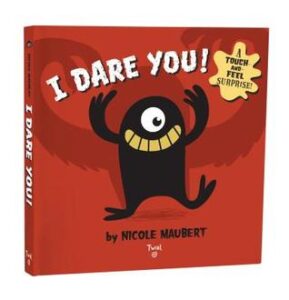 Try running around the room with this one, getting the kids to touch the witch’s warts, pet the monsters’ fur, and stick their hands in the slathering jaws of hungry beasts. As long as it keeps in one piece, it will be beloved.
Try running around the room with this one, getting the kids to touch the witch’s warts, pet the monsters’ fur, and stick their hands in the slathering jaws of hungry beasts. As long as it keeps in one piece, it will be beloved.
Monsters Go Night-Night by Aaron Zenz
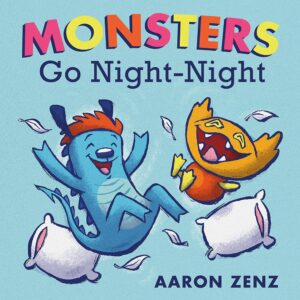
I adore this. I mean talk about a book that upsets expectations. I’m putting it on the younger list here because I can, but much like Mac Barnett and Adam Rex’s Guess Again (a highly underrated readaloud) this book upsets the expectations of its potentially jaded readership.
Grumpy Pants by Claire Messer
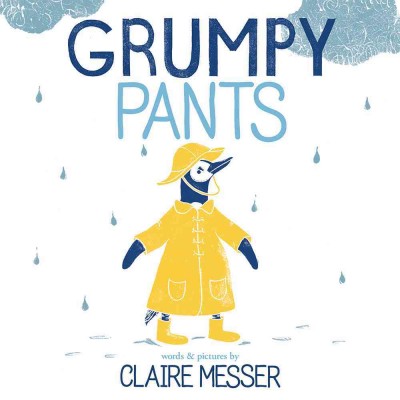
I had to be told by a children’s librarian in my branch that this book is a wonderful readaloud for groups. I knew it was lovely to look at but until she spoke up I never would have thought to consider it for large groups.
2016 Picture Book Readalouds: That You Can Sing
5 Little Ducks by Denise Fleming
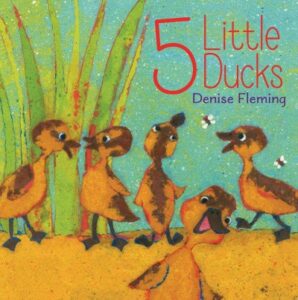
It still works if you don’t know the tune, but I think singing it is best. Plus look at that duck that’s front and center on the cover. How can you say no to that little guy?
Groovy Joe: Ice Cream & Dinosaurs by Eric Litwin, ill. Tom Lichtenheld
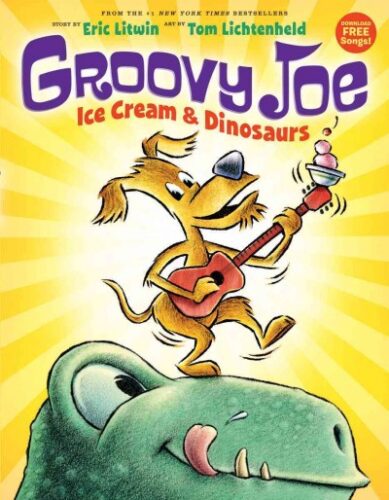
While the title does sound like free word associations for kids (“Name me two things your little brother would want at his birthday party”) this is the Pete the Cat author at work. The book’s pretty catchy. For the music, download the free song.
Old MacDonald Had a Truck by Steve Goetz, ill. Eda Kaban
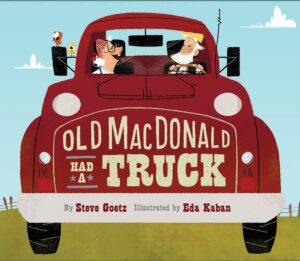
For years Jessica Souhami’s version of Old MacDonald was my favorite, and it may still be at the top of the ranking (WHEN is someone going to republish it?!???), but this book is gunning to be a close second. You’ve got Mrs. MacDonald welding, plenty of construction equipment, and just gorgeous art. Keep an eye on that Eda Kaban. That name may become better known in the future.
2016 Picture Book Readalouds: That Rhyme
A Dark, Dark Cave by Eric Hoffman, ill. Corey R. Tabor
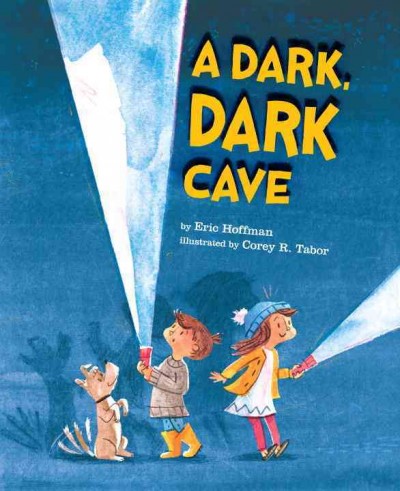
Aww. This was one of my favorites early in the year. It sort of reminds me of the Berenstain Bears classic Spooky Old Tree in a way. Fear, it seems, is a great motivator when coming up with picture book themes.
Dinosaur Rap by John Foster, ill. Debbie Harter, sung by Mikey Henry Jr.
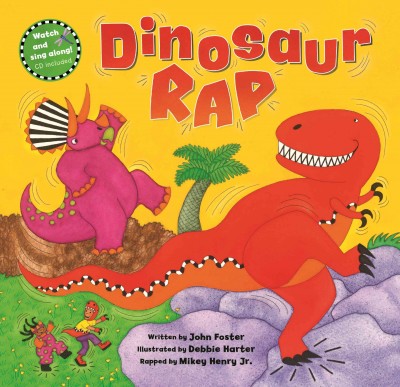
I usually avoid any book that includes the word “rap” anywhere near its title with a ten-foot-pole. But the bright art and fun rhymes convinced me otherwise. Technically I think it’s a song but I preferred reading it by itself. The rhymes hold up.
The Forgetful Knight by Michelle Robinson, ill. Fred Blunt
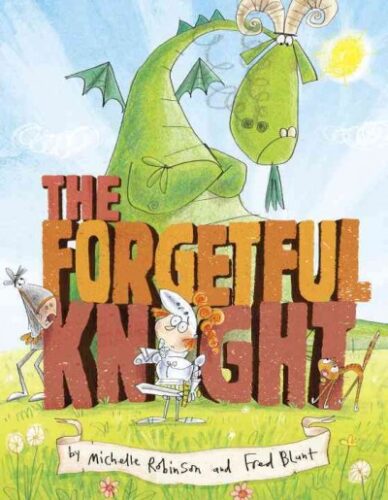
So much fun with a nice little twist at the end. And who doesn’t love a twist ending?
Hensel and Gretel Ninja Chicks by Corey Rosen Schwartz & Rebecca J. Gomez, ill. Dan Santat

Funny goes a long way with me, as you can probably tell.
A Toucan Can, Can You? by Danny Adlerman, ill. Various
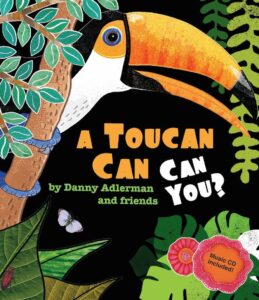
I think this is the first book on any of my lists to be reviewed on the site as well. Funny it took so long. Adlerman and company have created a truly funny book that also works as a writing assignment. Just smart stuff.
Swallow the Leader: A Counting Book by Danna Smith, ill. Kevin Sherry

More Kevin Sherry, please!
*holds out hand and makes a grabby motion*
2016 Picture Book Readalouds: For School Aged Kids
Chimpanzees for Tea! by Jo Empson
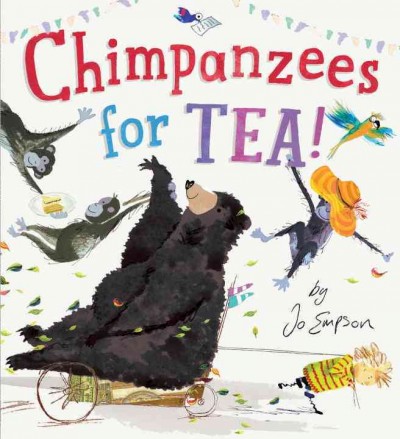
Remembering items from the story take a distinct turn for the silly in this book. I’m a sucker for readalouds where the kids get to yell at the characters for doing something wrong. In this case, the misremembered list builds to a nice chaotic frenzy over time. My favorite trope.
The Happiest Book Ever! by Bob Shea

If ever a humor award for picture book is created, Shea’s gonna sweep it every single year.
Hocus Pocus, It’s Fall! By Anne Sibley O’Brien
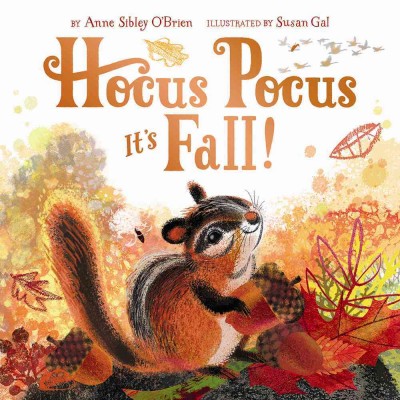
I know it’s seasonal, and usually I’d limit seasonal books to a different list, but I just loved this one. It has this little element where you open up a page to reveal something that works from a distance. Always important when reading to groups.
I Will Not Eat You by Adam Lehrhaupt, ill. Scott Magoon

You’ll pretty much have the kids hooked when you read and show them the title.
Is That Wise Pig? by Jan Thomas, Little Red and the Very Hungry Lion by Alex T. Smith

Jan Thomas could pretty much just repeat the same image over and over in a picture book and I’d find her work splendid. This is so funny and her art just pops. A kid in the next county could see it if you held it up. She’s also one of my storytime staples.
Leave Me Alone! by Vera Brosgol
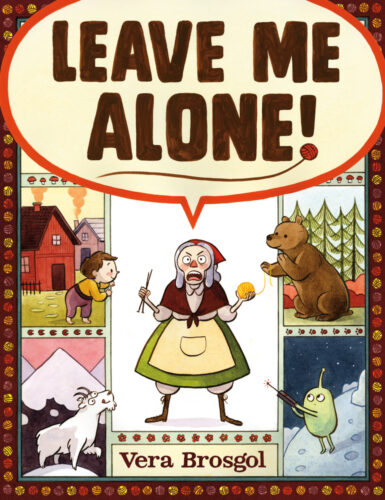
It’s perfect. No. Really. It is.
Max Speed by Stephen Shaskan
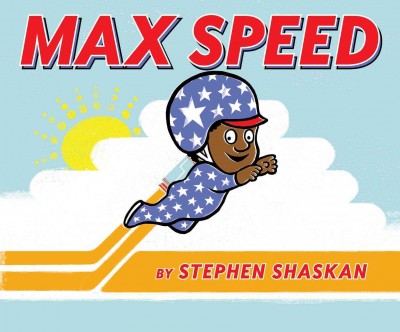
This was a huge hit at my kid’s daycare. I gave them a copy and they went gaga over it. And don’t worry. It has a happy ending.
One Day in the Eucalyptus Eucalyptus Tree by Daniel Bernstrom, ill. by Brendan Wenzel

To a certain extent this has been overshadowed by Wenzel’s other picture book this year They All Saw a Cat. That book has big readaloud potential in its own way, but if I were to have to pick between that and this one to read to a group, this would win every dang time. Hands down.
Panda Pants by Jacqueline Davies, ill. Sydney Hanson

I was trying to explain to my daughter today why pants are funny. What I should have done was just read her this book!
President Squid by Aaron Reynolds, ill. Sara Varon
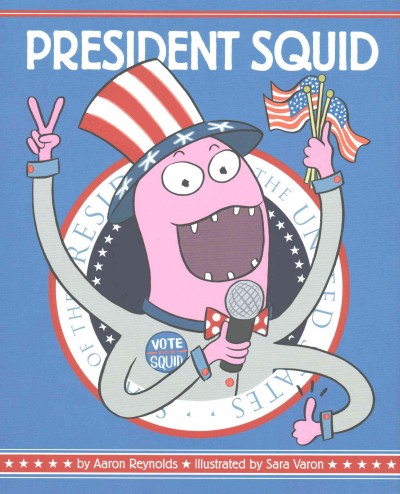
Read it. It’s cathartic. And don’t just do it once every four years either.
Quit Calling Me a Monster! by Jory John, ill. Bob Shea
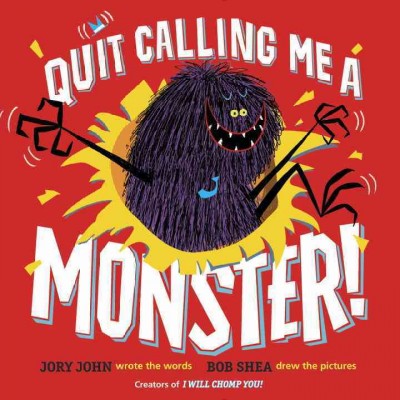
I MUCH prefer this over John & Shea’s previous outing I Will Chomp You. That book was fine. This one is sublime. I adore the hairy monster and his overly professional name.
That’s Not a Hippopotamus! by Juliette Maclver, ill. Sarah Davis
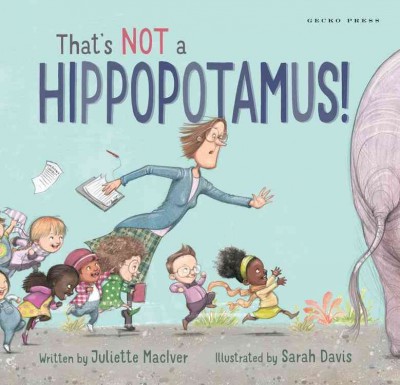
It’s frentic energy reminded me, just a little, of Hallie George’s Catch That Cookie! Had a GREAT ending too!
Interested in the other upcoming lists of this month? Here’s the schedule so that you can keep checking back:
December 1 – Board Books
December 2 – Board Book Adaptations
December 3 – Nursery Rhymes
December 4 – Picture Book Readalouds
December 5 – Rhyming Picture Books
December 6 – Alphabet Books
December 7 – Funny Picture Books
December 8 – Calde-Nots
December 9 – Picture Book Reprints
December 10 – Math Picture Books
December 11 – Bilingual Books
December 12 – International Imports
December 13 – Books with a Message
December 14 – Fabulous Photography
December 15 – Fairy Tales / Folktales
December 16 – Oddest Books of the Year
December 17 – Older Picture Books
December 18 – Easy Books
December 19 – Early Chapter Books
December 20 – Graphic Novels
December 21 – Poetry
December 22 – Fictionalized Nonfiction
December 23 – American History
December 24 – Science & Nature Books
December 25 – Transcendent Holiday Titles
December 26 – Unique Biographies
December 27 – Nonfiction Picture Books
December 28 – Nonfiction Chapter Books
December 29 – Novel Reprints
December 30 – Novels
December 31 – Picture Books


By:
Betsy Bird,
on 9/20/2016
Blog:
A Fuse #8 Production
(
Login to Add to MyJacketFlap)
JacketFlap tags:
Reviews,
picture books,
Chronicle,
Best Books,
Brendan Wenzel,
picture book readalouds,
Best Books of 2016,
2016 picture books,
2016 reviews,
Reviews 2016,
2017 Caldecott contenders,
2016 picture book readalouds,
Add a tag
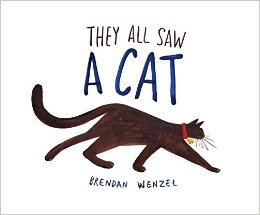 They All Saw a Cat
They All Saw a Cat
By Brendan Wenzel
Chronicle Books
$16.99
ISBN: 978-1-4521-5013-0
Ages 4-7
On shelves now
It’s funny. Unless you’re a teacher or librarian, a grown adult that does not work or live with children will come into very little contact with picture books. Then, one day, they produce a few kids and BLAMMO! They are shot into a world they haven’t visited since they were young themselves. They grab frantically at the classics, discover that a lot of them don’t work with very very young children (since when did Horton Hatches the Egg have so many words?!?), and then occasionally turn to the experts for help. And why? Parents’ reasons are not united on this front. Some read to their kids to instill a love of reading. Others to build little brains. Others to simply fill the long hours of the day. Occasionally a parent will also use a book to teach some kind of a lesson. If the parent is unlucky they will get stuck with a book sticky with didacticism (an unpleasant book that sucks all the joy out of the reading experience). But if they are lucky (or they are in the hands of a capable professional) they might find just the right book, teaching just the right lesson. Here’s an example: Let’s say you wanted to teach a kid empathy or how our perceptions change depending on our own experiences and who we are. How do you show that in 32 pages? Well, you could pick up some cloying, toxic dribble that overuses words like “hugs” and “friendship”. Nine times out of ten, that’s what’s going to happen. Or, if you are a clever parent, you pick up a book like They All Saw a Cat. It looks at first glance like it’s just about a cat. Delve a little deeper and you’ll find it about science and art and perception and empathy. And it does it all with very simple sentences, repetition, and a lot of white backgrounds. Not too shabby. Not too shabby at all.
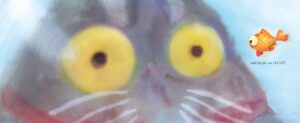 “The cat walked through the world, with its whiskers, ears, and paws . . .” In that walking it is seen. It is seen by a child, a dog, and a fox. It is seen by a fish, a mouse, and a bee. It is seen by a bird, a flea, a snake, a skunk, a worm, and a bat. And what’s important is that this “seeing” changes with every creature. For mice and dogs, the cat is perceived through the lens of their own interactions with it. For worms and bats the cat is only visible through the ways in which it moves through space (vibrations through the ground and the ways in which echolocation shape it). By the end we see a hodgepodge cat, a mix of how each animal sees it. Then the cat comes to the water, viewing its own reflection, “and imagine what it saw?”
“The cat walked through the world, with its whiskers, ears, and paws . . .” In that walking it is seen. It is seen by a child, a dog, and a fox. It is seen by a fish, a mouse, and a bee. It is seen by a bird, a flea, a snake, a skunk, a worm, and a bat. And what’s important is that this “seeing” changes with every creature. For mice and dogs, the cat is perceived through the lens of their own interactions with it. For worms and bats the cat is only visible through the ways in which it moves through space (vibrations through the ground and the ways in which echolocation shape it). By the end we see a hodgepodge cat, a mix of how each animal sees it. Then the cat comes to the water, viewing its own reflection, “and imagine what it saw?”
The book this actually reminded me of the most was that old Rudyard Kipling story “The Cat Who Walked By Himself”. Unlike that tale we never really get this book from the cat’s perspective. Indeed, the cat is often only visible when others see him. The similarity to Kipling comes with the language. That very first sentence, for example: “The cat walked through the world, with its whiskers, ears, and paws . . .” And as in the original art for that story, the cat here is often pictured from the back. There’s a lot of debate about whether or not a book written by one person and illustrated by another can ever be as strong as a book that is written and illustrated by the same artist. They All Saw a Cat makes a fairly strong argument that artist who are also authors are the better way to go. Wenzel’s sentences are so perfectly layered here. If anything, they match the personality of a cat. There aren’t many words, true. But the measured tone is at once soothing and scintillating. I liked how the book broke up the animals. The first three are potential predators. The second three are potential  prey. The final six are strict observers. It also ends perfectly with the best possible sentence. Not all picture books, no matter how beautiful they look, are capable of sticking their landings. This one does.
prey. The final six are strict observers. It also ends perfectly with the best possible sentence. Not all picture books, no matter how beautiful they look, are capable of sticking their landings. This one does.
In this book the publication page (where they tend to describe the artist’s process) gets a little slaphappy. It reads (and I am quoting this precisely), “The illustrations in this book were rendered in almost everything imaginable, including colored pencil, oil pastels, acrylic paint, watercolor, charcoal, Magic Marker, good old number 2 pencils, and even an iBook.” The other day I was listening to a podcast where one of the speakers speculated that including this kind of information in a book changes the adult reader’s perspective. Would I think less of this book if I found out it was done in digital ink? Possibly, though I should note that I was blown away by the art long before I ever turned to see how it was made. And while digital art is great and has its place, I’d like to see the program that replicates what Wenzel’s done here.
 The sheer beauty of the book is what strikes you first when you read it. Consider the two-page spread where on the left-hand side you see the cat through snake vision, and on the right-hand side you see the cat through skunk vision. The snake’s view is a vibrant shock of color, all yellows and reds and blues. The skunk’s in contrast, looks like the soft grainy sepia-tones of an old film. Maybe Casablanca. Put together, side-by-side, the same cat is its own opposite. But if Wenzel were constantly wowing you with eye-popping images that wouldn’t really support the narrative flow. That’s why the pacing of the book is key. Wenzel starts the book out very slowly, with lots of white backgrounds and views akin to what we see as people. The child, dog, and fox all see the cat similarly (though I loved the oversized bell around its neck, indicating the fox and dog’s superior sense of hearing through a visual medium). The fish is the first moment you start to separate from human visuals. The cat’s large, yellow eyes are 80% of the two pages. But it is the mouse’s Basquiat-esque view of the cat that steals the show. The red background, and the cat all teeth and claws, and terrifying eyes is a far cry from the cuddly creature at the start of the story. It’s also the moment when the child readers come to realize that perception is personal.
The sheer beauty of the book is what strikes you first when you read it. Consider the two-page spread where on the left-hand side you see the cat through snake vision, and on the right-hand side you see the cat through skunk vision. The snake’s view is a vibrant shock of color, all yellows and reds and blues. The skunk’s in contrast, looks like the soft grainy sepia-tones of an old film. Maybe Casablanca. Put together, side-by-side, the same cat is its own opposite. But if Wenzel were constantly wowing you with eye-popping images that wouldn’t really support the narrative flow. That’s why the pacing of the book is key. Wenzel starts the book out very slowly, with lots of white backgrounds and views akin to what we see as people. The child, dog, and fox all see the cat similarly (though I loved the oversized bell around its neck, indicating the fox and dog’s superior sense of hearing through a visual medium). The fish is the first moment you start to separate from human visuals. The cat’s large, yellow eyes are 80% of the two pages. But it is the mouse’s Basquiat-esque view of the cat that steals the show. The red background, and the cat all teeth and claws, and terrifying eyes is a far cry from the cuddly creature at the start of the story. It’s also the moment when the child readers come to realize that perception is personal.
An interesting criticism of this book is linked precisely to the more science-y aspects of the text. One of the commenters on a blog post I wrote, that included this book, said that, “I desperately wanted some nice science-y back matter to tell us how and why different animals see the cat the way they do. Sure, we can go OH, this animal must be colorblind! This animal ‘sees’ by sonar! But c’mon, throw us an edu-bone here. It felt like such a missed opportunity.” This is an interesting note. We’ve grown used to useful backmatter in this post-Core Curriculum world of ours. Would this book have been stronger if it had contained a science element to it? Yes and no. It would have been a real boon to teachers, you betcha, and probably to perceptive parents who could have turned it into a lesson for young readers. If I had to guess I’d say the reason it wasn’t done may have had something to do with the fact that Wenzel is mixing his fact and fiction here pretty closely. Each animal is “seeing” as it would in the wild, but that is not to say that the art is by any means scientific. The cartoonish quality to the animals (no better exemplified than in the mouse’s bulbous eyes) doesn’t hold up to close scrutiny. I would have very much liked notes on the accuracy of the art, but I can understand the fear of asking the reader to take the work too seriously. I don’t necessarily agree, but I understand it.
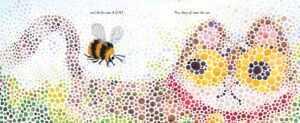 How do you discuss this book with kids? Well, you might read it to them, start to finish, and then ask them which picture shows what the cat really looks like. When they select (some will go with the human view but I’ve no doubt a couple will prefer the dog or bird p.o.v.s) you then tell them that actually all the pictures in this book are true. And if you really want to blow their little minds, you tell them that there’s a good chance that the way you see the world isn’t the same way the person next to you does. Everyone, everywhere sees the world different from his or her neighbor. Is it any wonder we have problems? The solution is to try and see things from another person’s view. Now, if the kids think you’re speaking literally or figuratively, it doesn’t really matter. You’ve planted the seed. Or, rather, the book has.
How do you discuss this book with kids? Well, you might read it to them, start to finish, and then ask them which picture shows what the cat really looks like. When they select (some will go with the human view but I’ve no doubt a couple will prefer the dog or bird p.o.v.s) you then tell them that actually all the pictures in this book are true. And if you really want to blow their little minds, you tell them that there’s a good chance that the way you see the world isn’t the same way the person next to you does. Everyone, everywhere sees the world different from his or her neighbor. Is it any wonder we have problems? The solution is to try and see things from another person’s view. Now, if the kids think you’re speaking literally or figuratively, it doesn’t really matter. You’ve planted the seed. Or, rather, the book has.
Let us do away with the notion of “cat people” vs. “dog people”. This book is for “people”. End of sentence. And if I got a little crazy in my first paragraph here, filling you in on my view of world peace via picture books, you’ll understand when you read this book. That tired old phrase to “walk a mile in someone else’s shoes” makes no sense to a kid. But travel a page through another animal’s eyes? There’s never been a better fictional picture book that allows you to do this. If we all see something as simple as a cat this differently, what else might we not see the same? It’s a treat to eye, ear, and mind, but don’t forget. We’re all going to see this book through our own lenses. What will your kids see when they look at it? Only one way to find out.
On shelves now.
Source: Galley sent from publisher for review.
Like This? Then Try:
Professional Reviews:
Other Mentions:
Videos:


By:
Betsy Bird,
on 8/24/2016
Blog:
A Fuse #8 Production
(
Login to Add to MyJacketFlap)
JacketFlap tags:
Canadian picture books,
picture book readalouds,
2016 picture books,
2016 reviews,
Reviews 2016,
2016 picture book readalouds,
Reviews,
picture books,
Canadian children's books,
Tundra Books,
Bill Slavin,
Add a tag
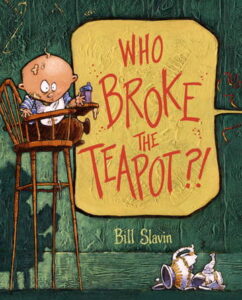 Who Broke the Teapot?!
Who Broke the Teapot?!
By Bill Slavin
Tundra Books
$16.99
ISBN: 978-1-77049-833-4
Ages 3-5
On shelves now
In the average life of a child, whodunits are the stuff of life itself. Who took the last cookie? Who used up all the milk and then didn’t put it on the shopping list? Who removed ALL the rolls of toilet paper that I SPECIFICALLY remember buying at the store on Sunday and now seem to have vanished into some toilet paper eating inter-dimension? The larger the family, the great the number of suspects. But picture books that could be called whodunits run a risk of actually going out and teaching something. A lesson about honesty or owning up to your own mistakes. Blech. I’ll have none of it. Hand me that copy of Bill Slavin’s Who Broke the Teapot?! instead, please. Instead of morals and sanctity I’ll take madcap romps, flashbacks, and the occasional livid cat. Loads of fun to read aloud, surprisingly beautiful to the eye, and with a twist that no one will see coming, Who Broke the Teapot?! has it all, baby. Intact teapot not included.
The scene of the crime: The kitchen. The family? Oblivious. As the mother enters the room it’s just your average morning. There’s a baby in a high chair, a brother attached to a ceiling fan by his suspenders, a dad still in his underwear reading the paper, a daughter eating pastries, a dog aiding her in this endeavor, and a cat so tangled up in wool that it’s a wonder you can still make out its paws. And yet in the doorway, far from the madding crowd, sits a lone, broken, teapot. Everyone proclaims innocence. Everyone seems trustworthy in that respect. Indeed, the only person to claim responsibility is the baby (to whom the mother tosses a dismissive, “I doubt it”). Now take a trip back in time just five minutes and all is revealed. The true culprit? You’ll have to read the book yourself. You final parting shot is the mother accepting a teapot stuck together with scotch tape and love from her affectionate offspring.
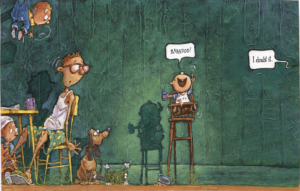 Generally when I write a picture book review I have a pretty standard format that I adhere to. I start with an opening paragraph (done), move on to a description of the plot in the next paragraph (so far, so good), and in the third paragraph I talk about some aspect of the writing. It could be the overall theme or the writing or the plotting. After that I talk about the art. This pattern is almost never mucked with . . . until today!! Because ladies and gents, you have just GOT to take a gander at what Mr. Slavin’s doing here with his acrylics. Glancing at the art isn’t going to do it. You have to pick this book up and really inspect the art. For the bulk of it the human characters are your usual cartoony folks. Very smooth paints. But even the most cursory glance at the backgrounds yields rewards. The walls are textured with thick, luscious paints adhering to different patterns. There’s even a touch of mixed media to the old affair, what with cat’s yarn being real thread and all (note too how Slavin seamlessly makes it look as if the yarn is wrapped around the legs of the high chair). Then the typography starts to get involved. The second time the mom says “Who broke the teapot?!” the words look like the disparate letters of a rushed ransom note. As emotions heat up (really just the emotions of the mom, to be honest) the thick paints crunch when she says “CRUNCHED”, acquire zigzags as her temper unfurls, and eventually belie the smoothness of the characters’ skin when the texture invades the inside of the two-page spread of the now screaming mother’s mouth.
Generally when I write a picture book review I have a pretty standard format that I adhere to. I start with an opening paragraph (done), move on to a description of the plot in the next paragraph (so far, so good), and in the third paragraph I talk about some aspect of the writing. It could be the overall theme or the writing or the plotting. After that I talk about the art. This pattern is almost never mucked with . . . until today!! Because ladies and gents, you have just GOT to take a gander at what Mr. Slavin’s doing here with his acrylics. Glancing at the art isn’t going to do it. You have to pick this book up and really inspect the art. For the bulk of it the human characters are your usual cartoony folks. Very smooth paints. But even the most cursory glance at the backgrounds yields rewards. The walls are textured with thick, luscious paints adhering to different patterns. There’s even a touch of mixed media to the old affair, what with cat’s yarn being real thread and all (note too how Slavin seamlessly makes it look as if the yarn is wrapped around the legs of the high chair). Then the typography starts to get involved. The second time the mom says “Who broke the teapot?!” the words look like the disparate letters of a rushed ransom note. As emotions heat up (really just the emotions of the mom, to be honest) the thick paints crunch when she says “CRUNCHED”, acquire zigzags as her temper unfurls, and eventually belie the smoothness of the characters’ skin when the texture invades the inside of the two-page spread of the now screaming mother’s mouth.
So, good textures. But let us not forget in all this just how important the colors of those thick paints are as well. Watching them shift from one mood to another is akin to standing beneath the Northern Lights. You could be forgiven for not noticing the first, second, third, or even fourth time you read the book. Yet these color changes are imperative to the storytelling. As emotions heat up or the action on the page ramps up, the cool blues and greens ignite into hot reds, yellows, and oranges. Taken as a whole the book is a rainbow of different backgrounds, until at long last everything subsides a little and becomes a chipper cool blue.
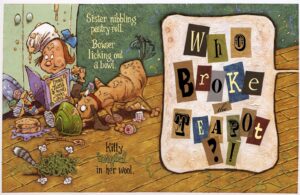 Now kids love a good mystery, and I’m not talking just the 9 and 10-year-olds. Virtually every single age of childhood has a weakness for books that set up mysterious circumstances and then reveal all with a flourish. Heck, why do you think babies like the game of peekaboo? Think of it as the ultimate example of mystery and payoff. Picture book mysteries are, however, far more difficult to write than, say, an episode of Nate the Great. You have to center the book squarely in the child’s universe, give them all the clues, and then make clear to the reader what actually happened. To do this you can show the perpetrator of the crime committing the foul deed at the start of the book or you can spot clues throughout the story pointing clearly to the miscreant. In the case of Who Broke the Teapot, Slavin teaches (in his own way) that old Sherlock Holmes phrase, “When you have eliminated the impossible, whatever remains, however improbable, must be the truth.”
Now kids love a good mystery, and I’m not talking just the 9 and 10-year-olds. Virtually every single age of childhood has a weakness for books that set up mysterious circumstances and then reveal all with a flourish. Heck, why do you think babies like the game of peekaboo? Think of it as the ultimate example of mystery and payoff. Picture book mysteries are, however, far more difficult to write than, say, an episode of Nate the Great. You have to center the book squarely in the child’s universe, give them all the clues, and then make clear to the reader what actually happened. To do this you can show the perpetrator of the crime committing the foul deed at the start of the book or you can spot clues throughout the story pointing clearly to the miscreant. In the case of Who Broke the Teapot, Slavin teaches (in his own way) that old Sherlock Holmes phrase, “When you have eliminated the impossible, whatever remains, however improbable, must be the truth.”
I love it when a book turns everything around at the end and asks the reader to think long and hard about what they’ve just seen. Remember the end of The Cat in the Hat when everything’s been cleaned up just in time and the mother comes in asking the kids what they got up to while she was gone? The book ends with a canny, “Well, what would YOU do if your mother asked YOU?” Who Broke the Teapot?! does something similar at its end as well. The facts have been laid before the readers. The baby has claimed responsibility and maybe he is to blame after all. But wasn’t the mother just as responsible? It would be very interesting indeed to poll a classroom of Kindergartners to see where they ascribe the bulk of the blame. It may even say something about a kid if they side with the baby more or the mommy more.
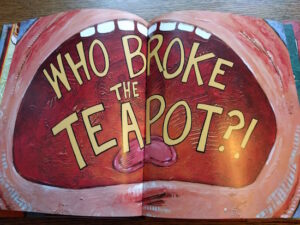 I also love that the flashback does far more than explain who broke the teapot. It explains why exactly most of the members of this family are dwelling in a kind of generally accepted chaotic stew. You take it for granted when you first start reading. A kid’s hanging from a ceiling fan? Sure. Yeah. That happens. But the explanation, when it comes, belies that initial response. The parents don’t question his position so you don’t question it. That is your first mistake. Never take your lead from parents. And speaking of the flashback, let’s just stand aside for a moment and remember just how sophisticated it is to portray this concept in a picture book at all. You’re asking a child audience to accept that there is a “before” to every book they read. Few titles go back in time to explain how we got to where we are now. Slavin’s does so easily, and it will be the rare reader that can’t follow him on this trip back into the past.
I also love that the flashback does far more than explain who broke the teapot. It explains why exactly most of the members of this family are dwelling in a kind of generally accepted chaotic stew. You take it for granted when you first start reading. A kid’s hanging from a ceiling fan? Sure. Yeah. That happens. But the explanation, when it comes, belies that initial response. The parents don’t question his position so you don’t question it. That is your first mistake. Never take your lead from parents. And speaking of the flashback, let’s just stand aside for a moment and remember just how sophisticated it is to portray this concept in a picture book at all. You’re asking a child audience to accept that there is a “before” to every book they read. Few titles go back in time to explain how we got to where we are now. Slavin’s does so easily, and it will be the rare reader that can’t follow him on this trip back into the past.
I think the only real mystery here is why this book isn’t better known. And its only crime is that it’s Canadian, and therefore can’t win any of the big American awards here in the States. It’s also too amusing for awards. Until we get ourselves an official humor award for children’s books, titles like Who Broke the Teapot?! are doomed to fly under the radar. That’s okay. This is going to be the kind of book that children remember for decades. They’re going to be the ones walking into their public libraries asking the children’s librarians on the desks to bring to them an obscure picture book from their youth. “There was a thing that was broken . . . like a china plate or something . . . and there was this cat tied up in string?” You have my sympathies, children’s librarians of the future. In the meantime, better enjoy the book now. Whether it’s read to a large group or one-on-one, this puppy packs a powerful punch.
On shelves now
Source: Publisher sent final copy for review.
Like This? Then Try:


By:
Betsy Bird,
on 7/14/2016
Blog:
A Fuse #8 Production
(
Login to Add to MyJacketFlap)
JacketFlap tags:
Megan Halsey,
Wendy Anderson Halperin,
picture book readalouds,
2016 picture books,
2016 reviews,
Reviews 2016,
2016 picture book readalouds,
Christee Curran-Bauer,
Danny Adlerman,
Dar (Hosta),
Jim Babjak,
Kevin Kammeraad,
Kim Adlerman,
picture book song books,
Ralph Masiello,
Symone Banks,
The Kids at Our Home,
Reviews,
Lindsay Barrett George,
Demi,
Ashley Wolff,
Leeza Hernandez,
Pat Cummings,
Add a tag
 A Toucan Can, Can You?
A Toucan Can, Can You?
By Danny Adlerman
Illustrated by Lindsay Barrett George, Megan Halsey, Ashley Wolff, Demi, Ralph Masiello, Wendy Anderson Halperin, Kevin Kammeraad, Pat Cummings, Dar (Hosta), Leeza Hernandez, Christee Curran-Bauer, Kim Adlerman, and Symone Banks
Music by Jim Babjak
The Kids at Our House Children’s Books
$19.95
ISBN: 9781942390008
Ages 3-6
On shelves now
Under normal circumstances I don’t review sequels. I just don’t, really. Sequels, generally speaking, require at least a rudimentary knowledge of the preceding book. If I have to spend half a review catching a reader up on the book that came before the book that I’m actually reviewing, that’s just a waste of everyone’s time. Better to skip sequels entirely, and I include chapter book sequels, YA sequels, middle grade sequels, nonfiction sequels, graphic novel sequels, and easy book sequels in that generalization. I would even include picture book sequels, but here I pause for a moment. Because once in a while a picture book sequel will outshine the original. Such is the case with Danny Adlerman’s audibly catchy and visually eclectic A Toucan Can, Can You? A storyteller’s (and song-and-dance parent’s) dream, the book is is a sequel to the book How Much Wood Could a Woodchuck Chuck but comes into its own as a writing assignment for some, a storytime to others, and a darn good book for everybody else.
Many of us are at least passingly familiar with that old poem, “How much wood could a woodchuck chuck if a woodchuck could chuck wood?” But why stop with the woodchuck? What other compound words can you break up in amusing ways? And so we are sucked into a delightful world of teaspoons spooning tea, spaceships shipping space, and ice cream screaming “ice!” Each one of these catchy little poems (which are set to music on the accompanying CD) is paired with art from an impressive illustrator. Part collaboration and part exercise in audible frivolity, Danny Adlerman’s little book packs a great big punch.
For a group collaboration to work in a picture book there needs to be a reason for it to even exist. Which is to say, why have different people do different pieces of art for the same book? To best justify bringing these artists together you need a strong hook. And brother, I can’t think of a stronger hook then a catchy little rhyme, turned into a song, and given some clever additional rhymes to go along with it. Let’s hear it for the public domain! It’s little wonder that the customary “Note to Parents and Teachers” found in books of this sort appears at the beginning of the book rather than the end. In it, mention is made of the fact that the accompanying CD has both music with the lyrics and music without the lyrics, allowing kids to make up their own rhymes. I can attest as someone who did storytimes for toddlers and preschoolers for years that music can often be a librarian’s best friend. Particularly if it has a nice little book to show off as well. So for the storytimes for younger children, go with the words. And for the older kids? I think a writing assignment is waiting in the wings.
I was quite taken with the rhymes that already exist in this book, though. In fact, my favorite (language-wise) might have to be “How much bow could a bow tie tie if a bow tie could tae bo?” if only because “tae bo” makes shockingly few cameos in picture books these days. Finding the perfect collaboration between word and text can be difficult but occasionally the book hits gold. One example would be on the rhyme “How much ham could a hamster stir if a hamster could stir ham?” Artist Leeza Hernandez comes up with a rough riding hamster in cowboy gear astride an energetic hog. Two great tastes that taste great together.
Obviously the problem with any group collaboration is that some pieces are going to be stronger than others. But I have to admit that when I looked at that line-up I was a bit floored. In an impressive mix of established artists and new up-and-comers, Adlerman pairs his illustrators alongside rhymes that best show off their talents. Demi, for example, with her meticulous details and intricate style, is perfectly suited to honeycombs, honey, and the thin veins in the wing of a honeybee, holding a comb aloft. Meanwhile Wendy Anderson Halperin tackles the line “How much paint could a paintbrush brush” by rendering a variety of famous works, from Magritte to Diego Rivera in her two-page spread. Mind you, some artists are more sophisticated than others, and the switch between styles threatens to give one a bit of whiplash in the process. Generally speaking, however, it’s lovely. And I must confess that it was only on my fourth or fifth reading that I realized that the lovely scene illustrated by newcomer Symone Banks at the end of the book is dotted with animals done by the other artists, hidden in the details.
I don’t have to do storytimes anymore. In my current job my contact with kids is fairly minimal. But I have a two-year-old and a five-year-old at home and that means all my performance skills are on call whenever those two are around. I admit it. I need help. And books like A Toucan Can: Can You? can be lifesavers to parents like myself. If we had our way there would be a book-of-the-week club out there that personally delivered song-based picture books to our door. Heck, it should be a book-of-the-DAY club. I mean, let’s be honest. Raise a glass then and toast to Danny Adlerman and his fabulous friends. Long may their snowshoes shoo, their jellyfish fish, and their rockhoppers hop hop hop.
On shelves now.
Like This? Then Try:
Source: Galley sent from author for review.


By:
Betsy Bird,
on 4/28/2016
Blog:
A Fuse #8 Production
(
Login to Add to MyJacketFlap)
JacketFlap tags:
picture books,
Harper Collins,
Best Books,
Katherine Tegen Books,
Brendan Wenzel,
preschool storytime readalouds,
picture book readalouds,
Best Books of 2016,
2016 picture books,
2016 reviews,
Reviews 2016,
2016 picture book readalouds,
Daniel Bernstrom,
Reviews,
Add a tag
 One Day in the Eucalyptus, Eucalyptus Tree
One Day in the Eucalyptus, Eucalyptus Tree
By Daniel Bernstrom
Illustrated by Brendan Wenzel
Katherine Tegen Books (an imprint of Harper Collins)
$17.99
ISBN: 978-0-06-235485-3
Ages 3-6
On shelves May 3rd
Like any children’s librarian, I like to assess each picture book that crosses by my eyeballs for readaloud potential. While every picture book (even the wordless ones) can be read aloud to a large group of children, only a select few thrive in that environment. It takes a certain magical combination of art and text to render a story readaloud-perfect. Books you can sing have a leg up. Ditto books with flaps or pull-tabs. But the nice thing about Bernstrom’s book One Day in the Eucalyptus, Eucalyptus Tree is that it doesn’t need to rely on those extra features to enrapture an audience. The book’s lilting rhymes, when practiced beforehand, have the potential to render an audience entranced. Add in the art of Brendan Wenzel, and how well it reads across a room, and you’ve got yourself the makings of what might possibly be the best readaloud picture book of the year.
A boy and his whirly-twirly toy are just the first things to disappear down the gullet of a hungry yellow snake. But rather than bemoan his fate, the boy gets to work in his new role as the snake’s inner id. Commenting on the sheer amount of room and space in the belly, the boy cajoles the snake into eating more and more and more. From birds and worms, to mossy sloths, to a single apple bearing a tiny fly, the creatures slide down the snake’s rapidly expanding throat. A final meal proves too much for the voracious viper and next thing you know boy, toy, and a host of other animals are upchucked back into the world from whence they came. A sly illustration at the end suggests that history may repeat itself soon.
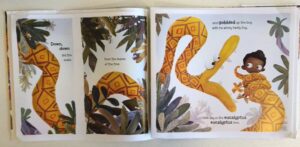 It’s not as if Mr. Bernstrom is the first person to find the word “eucalyptus” so exceedingly delicious to both tongue and ear, but he certainly seems to have been the most prominent in recent memory. As I read the book the language of the reading triggered something in my brain. Something long forgot. And though his name evokes strong feelings in every possible direction, it was Rudyard Kipling I thought of as I read this tale. Specifically the tale of “How the Elephant Got His Trunk”. Though that story does not realize how superb the word “eucalyptus” is when repeated, Kipling got a great deal of mileage out of illustrating thoughts with words. Terms like “great grey greasy Limpopo river”, “Kolokolo Bird”, and “the Bi-Coloured-Python-Rock-Snake” make those of us reading the stories aloud sound good. Bernstrom is writing for a younger audience so he doesn’t flex his muscles quite as far as Kipling did, but at the same time you recognize that he has the potential to do so. One hopes his future publishing plans may include longer stories just meant for sharing aloud. Lord knows we need more authors like that these days.
It’s not as if Mr. Bernstrom is the first person to find the word “eucalyptus” so exceedingly delicious to both tongue and ear, but he certainly seems to have been the most prominent in recent memory. As I read the book the language of the reading triggered something in my brain. Something long forgot. And though his name evokes strong feelings in every possible direction, it was Rudyard Kipling I thought of as I read this tale. Specifically the tale of “How the Elephant Got His Trunk”. Though that story does not realize how superb the word “eucalyptus” is when repeated, Kipling got a great deal of mileage out of illustrating thoughts with words. Terms like “great grey greasy Limpopo river”, “Kolokolo Bird”, and “the Bi-Coloured-Python-Rock-Snake” make those of us reading the stories aloud sound good. Bernstrom is writing for a younger audience so he doesn’t flex his muscles quite as far as Kipling did, but at the same time you recognize that he has the potential to do so. One hopes his future publishing plans may include longer stories just meant for sharing aloud. Lord knows we need more authors like that these days.
The story itself sounds familiar when you read it, but that may have to do more with familiar tropes than a tale we’ve actually seen done. The book also taps into a very popular method of extracting eaten creatures from predators’ bellies: burping. Vomiting works too, though the word sounds more disgusting, so usually in cases like this book the critters are released in a big old burp. In this case, we’re basically seeing a nature-based version of that Monty Python skit where the diner is persuaded to eat one final item (“It’s wafer-thin”). It’s odd to enjoy so much a book where a kid tricks the animal it is within to throw up, but there you go. The storytelling itself is top notch too, though I had a moment of confusion when the snake ate the beehive. Seems to me that that moment is where the boy’s plan potentially takes a turn south. Being stuck in a snake’s belly is one thing. Being stuck in a snake’s belly with flying, stinging insects? Thanks but no.
 Illustrator Brendan Wenzel burst onto the children’s picture book illustration scene in 2014 but his rise in prominence since that time has been slow. The artist first caught everyone’s eye when he illustrated Angela DiTerlizzi’s Some Bugs but it was the cover art of Ellen Jackson’s Beastly Babies the following year that was the most eye-catching. That cover sold that book. An ardent conservationist, it makes a lot of sense to turn to Wenzel when you’ve a story chock full of sloths, snakes, and bees. With Bernstrom’s tale, Wenzel must render this tale in the style of There Was an Old Lady Who Swallowed a Fly. Which is to say, he needs to balance horror with humor. Books where the protagonist gets eaten are common. Books where the protagonist gets eaten and then continues to comment on the action are rare. Wenzel’s snake falls into that category of villains that must be vicious enough to serve as a legitimate threat, but tame enough that a four-year-old won’t fear them on sight. To do this, Wenzel’s art takes on a distinctly jovial tone that treads towards the cartoonish without ever falling in completely. The colors are bright but not overwhelming, just as the action is consistent without horrifying the audience. Most of the creatures handle being eaten with gentle good grace (though the sloth looks more than a little put out about the whole thing).
Illustrator Brendan Wenzel burst onto the children’s picture book illustration scene in 2014 but his rise in prominence since that time has been slow. The artist first caught everyone’s eye when he illustrated Angela DiTerlizzi’s Some Bugs but it was the cover art of Ellen Jackson’s Beastly Babies the following year that was the most eye-catching. That cover sold that book. An ardent conservationist, it makes a lot of sense to turn to Wenzel when you’ve a story chock full of sloths, snakes, and bees. With Bernstrom’s tale, Wenzel must render this tale in the style of There Was an Old Lady Who Swallowed a Fly. Which is to say, he needs to balance horror with humor. Books where the protagonist gets eaten are common. Books where the protagonist gets eaten and then continues to comment on the action are rare. Wenzel’s snake falls into that category of villains that must be vicious enough to serve as a legitimate threat, but tame enough that a four-year-old won’t fear them on sight. To do this, Wenzel’s art takes on a distinctly jovial tone that treads towards the cartoonish without ever falling in completely. The colors are bright but not overwhelming, just as the action is consistent without horrifying the audience. Most of the creatures handle being eaten with gentle good grace (though the sloth looks more than a little put out about the whole thing).
The idea of being eaten whole is as old as “Little Red Riding Hood”. Heck, it’s even older than that. Look at the Greek myths of Cronus devouring his children whole. Look at any myth or legend that talks of children springing unharmed or fully formed from within nasty beasties. Together, Bernstrom and Wenzel take this ancient idea and turn it into a trickster tale. Usually it’s the eater doing the tricking, and not the eaten, but One Day in the Eucalyptus Eucalyptus Tree isn’t afraid to shake things up (or, for that matter, swallow them down). An oddly peppy little tale of surviving through another’s hubris, this is bound to become one of those readaloud picture books that teachers and librarians lean heavily on for decades to come. Look out, Bernstrom and Wenzel. You guys just went and created for yourselves a masterpiece.
On shelves May 3rd.
Source: F&G sent from publisher for review.
Like This? Then Try:
Professional Reviews:

This is the kind of award librarians should know about and don’t tend to. For anyone searching for good picture book readalouds, this list is invaluable. Read on:
Colorado Libraries for Early Literacy Announces 2016 CLEL Picture Book Awards Shortlists
 Denver, Colorado, December 15, 2015 – Colorado Libraries for Early Literacy (CLEL) announces the Shortlist titles for the 2016 CLEL Bell Picture Book Award. The CLEL Bell Picture Book Awards are a national award designed to recognize picture books that provide excellent support of early literacy development in young children.
Denver, Colorado, December 15, 2015 – Colorado Libraries for Early Literacy (CLEL) announces the Shortlist titles for the 2016 CLEL Bell Picture Book Award. The CLEL Bell Picture Book Awards are a national award designed to recognize picture books that provide excellent support of early literacy development in young children.
The Shortlist includes 25 titles- five books in each of the five categories representing an early literacy practices: Read, Write, Sing, Talk and Play. Research shows that engaging children in these practices builds language skills and prepares children to become successful readers.
Winning titles, one from each category, will be announced on February 5, 2016. The shortlists are:
Read:
Books for Me! by Sue Fliess; illustrated by Mike Laughead (Two Lions), The Boy & the Book by David Michael Slater; illustrated by Bob Kolar (Charlesbridge), Where Are My Books? by Debbie Ridpath Ohi, Duncan the Story Dragon by Amanda Driscoll (Random House), Sloth Slept On by Frann Preston-Gannon (Sterling?s Childrens Books)
Write:
Around the World: Follow the Trail by Katie Haworth; illustrated by Craig Shuttlewood (Little Bee Books), By Mouse and Frog by Deborah Freedman (Viking Books for Young Readers), How to Draw a Dragon by Douglas Florian (Beach Lane Books), Inside this Book (are three books) by Barney Saltzberg (Abrams Appleseed), Knit Together by Angela Dominguez (Penguin Group)
Sing:
Hiccupotamus by Steve Smallman; illustrated by Ada Grey (Tiger Tales), Mother Goose’s Pajama Party by Danna Smith; illustrated by Virginia Allyn (Doubleday Books for Young Readers), Nose to Toes, You Are Yummy! by Tim Harrington (Balzer + Bray), Cock-a-Doodle-Doo-Bop! by Michael Ian Black; illustrated by Matt Myers, (Simon & Schuster Books for Young Readers), Music Class Today! by David Weinstone; illustrated by Vin Vogel (Farrar, Straus and Giroux (BYR))
Talk:
One Word from Sophia by Jim Averbeck; illustrated by Yasmeen Ismail (Atheneum Books), A Fish to Feed by Ellen Mayer; illustrated by Ying-Hwa Hu (Star Bright Books), Can You Whoo, Too? by Harriet Ziefert; illustrated by Sophie Fatus (Blue Apple Books), BAH! Said the Baby by Jennifer Plecas (Philomel Books), I Don’t Want to Be a Frog by Dev Petty; illustrated by Mike Boldt (Doubleday Books)
Play:
Tickle Monster by Edouard Manceau (Abrams), On the Ball by Brian Pinkney (Disney Hyperion), Bob and Flo by Rebecca Ashdown (Houghton Mifflin Harcourt), Little Baby Buttercup by Linda Ashman; illustrated by You Byun (Nancy Paulsen Books), Book-O-Hats: A Wearable Book by Donald Lemke; illustrated by Bob Lentz (Capstone Young Readers)


By:
Betsy Bird,
on 9/23/2015
Blog:
A Fuse #8 Production
(
Login to Add to MyJacketFlap)
JacketFlap tags:
Reviews,
Penguin,
Best Books,
Dial Books for Young Readers,
a cool cool robot,
Adam Rubin,
picture book readalouds,
Best Books of 2015,
Reviews 2015,
2015 picture books,
Daniel Salmeri,
Add a tag
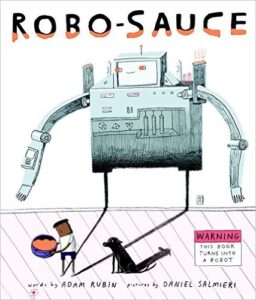 Robo-Sauce
Robo-Sauce
By Adam Rubin
Illustrated by Daniel Salmieri
Dial (an imprint of Penguin Books)
$18.99
ISBN: 978-0525428879
Ages 4-6
On shelves October 20th.
When I whip out the old we’re-living-in-a-golden-age-of-picture-book-creation argument with colleagues and friends, they humor what I’m sure they consider to be my hyperbole. Suuuuuure we are, Betsy. Not prone to exaggeration or anything, are you? But honestly, I think I could make a case for it. Look at the picture books of the past. They were beautiful, intricately crafted, and many of them are memorable and pertinent to child readers today. What other art form for kids can say as much? You don’t exactly have five-year-olds mooning over Kukla, Fran and Ollie these days, right (sorry, mom)? But hand them Goodnight Moon and all is well. Now look at picture books today. We’re living in a visual learner’s world. The combination of relaxed picture books standards (example: comics and meta storytelling are a-okay!), publishers willing to try something new and weird, and a world where technology and visual learning plays a heavy hand in our day-to-day lives yields creative attempts hitherto unknown or impossible to author/illustrators as recently as ten years ago. And when I try to think of a picture that combines these elements (meta storytelling / new and weird / technology permeating everything we do) no book typifies all of this better or with as much panache as Robo-Sauce. Because if I leave you understanding one thing today it is this: This may well contain the craziest picture book construction from a major publisher I have EVER seen. No. Seriously. This is insane. Don’t say I didn’t warn you either.
We all know that kid who thinks pretending to be a robot is the most fun you can have. When the hero of this story tries it though he just ends up annoying his family. That’s when the narrator starts talking to him directly. What if there was a recipe for turning yourself into a REAL robot? Would you make it? Would you take it? You BET you would! But once the boy starts destroying things in true mechanical fashion (I bet you were unaware that robots were capable of creating tornadoes, weren’t you?), it’s pretty lonely. The narrator attempts to impart a bit of a lesson here about how to appreciate your family/dog/life but when it hands over the antidote the robot destroys it on sight. Why? Because it’s just created a Robo-Sauce Launcher with which to turn its family, its dog, the entire world, and even the very book you are reading into robots! How do you turn a normal picture book into a robot? Behold the pull out cover that wraps around the book. Once you put it on and open the other cover, the text and images inside are entirely robotized. Robo-Domination is near. It may, however, involve some pretty keen cardboard box suits.
So you’re probably wondering what I meant when I said that the book has a cover that turns into a robot book. Honestly, I tried to figure out how I would verbally explain this. In the end I decided to do something I’d never done before. For the first time ever, I’m including a video as part of my review. Behold the explanation of the book’s one-of-a-kind feature:
These days the idea that a narrator would speak directly to the characters in a book is par for the course. Breaking down the fourth wall has grown, how do you say, passé. We almost expect all our books to be interactive in some way. If Press Here made the idea of treating a book like an app palatable then it stands to reason that competing books would have to up the ante, as it were. In fact, I guess if I’m going to be perfectly honest here, I think I’ve kind of been waiting for Robo-Sauce for a long time. Intrusive narrators, characters you have to yell at, books you shake, they’re commonplace. Into this jaded publishing scene stepped Rubin and Salmieri. They’re New York Times bestsellers in their own right ( Dragons Love Tacos) so they’re not exactly newbies to the field. They’ve proven their selling power. But by what witchcraft they convinced Penguin to include a shiny pull out cover and to print a fifth of the book upside down, I know not. All I can be certain of is that this is a book of the moment. It is indicative of something far greater than itself. Either it will spark a new trend in picture books as a whole or it will be remembered as an interesting novelty piece that typified a changing era.
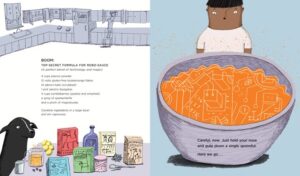 Let’s look at the book itself then. In terms of the text, I’m a fan. The narrator’s intrusive voice allows the reader to take on the role of adult scold. Kids love it when you yell at a book’s characters for being too silly in some way and this story allows you to do precisely that. Admittedly, I do wish that Rubin had pushed the narrator-trying-to-teach-a-lesson aspect a little farther. If the lesson it was trying to impart was a bit clearer than just the standard “love your family” shtick then it could have had more of a punch. Imagine if, instead, the book was trying to teach the boy about rejecting technology or something like that. Any picture book that could wink slyly at the current crop of drop-the-iPhone-pick-up-a-book titles currently en vogue would be doing the world a service. I’m not saying I disagree with their message. They’re just all rather samey samey and it would be nice to see someone poke a little fun at them (while still, by the end, reinforcing the same message).
Let’s look at the book itself then. In terms of the text, I’m a fan. The narrator’s intrusive voice allows the reader to take on the role of adult scold. Kids love it when you yell at a book’s characters for being too silly in some way and this story allows you to do precisely that. Admittedly, I do wish that Rubin had pushed the narrator-trying-to-teach-a-lesson aspect a little farther. If the lesson it was trying to impart was a bit clearer than just the standard “love your family” shtick then it could have had more of a punch. Imagine if, instead, the book was trying to teach the boy about rejecting technology or something like that. Any picture book that could wink slyly at the current crop of drop-the-iPhone-pick-up-a-book titles currently en vogue would be doing the world a service. I’m not saying I disagree with their message. They’re just all rather samey samey and it would be nice to see someone poke a little fun at them (while still, by the end, reinforcing the same message).
As for Salmieri’s art, the limited color palette is very interesting. You’ve your Day-Glo orange, black, white, brown, and pale pink (didn’t see that one coming). Other colors make the occasional cameo but the bulk of the book is pretty limited. It allows the orange to shine (or, in the case of the robot cover, the limited palette allows for something particularly shiny). And check out that subtle breaking down of visual stereotypes! Black dad and white mom. A sister that enjoys playing with trucks. I am ON BOARD with all this.
I won’t be the last parent/librarian/squishy human to hold this book in my hands and wonder what the heck to do with it. What I do know is that it’s a lot of fun. Totally original. And it has a bunch of robots in it causing massive amounts of destruction. All told, I’d say that’s a win. So domo arigato, Misters Rubin and Salmieri. Domo arigato a whole bunch.
On shelves October 20th.
Source: Galley sent from publisher for review.
Like This? Then Try:
Professional Reviews: A star from Publishers Weekly, Kirkus,
Misc: Still need some help figuring out the cover? Check out the book’s website here.


By:
Betsy Bird,
on 6/12/2014
Blog:
A Fuse #8 Production
(
Login to Add to MyJacketFlap)
JacketFlap tags:
Reviews,
picture book,
picture books,
Simon and Schuster,
Atheneum,
Best Books,
funny picture books,
picture book readalouds,
Best Books of 2014,
Reviews 2014,
2014 picture book readalouds,
2014 picture books,
2014 reviews,
Add a tag
 Hug Machine
Hug Machine
By Scott Campbell
Atheneum (an imprint of Simon & Schuster)
$16.99
ISBN: 978-1-4424-593509
Ages 3-7
On shelves August 26th
Do you remember that old Shel Silverstein poem “Hug O’ War”? This may be considered sacrilege but did you ever notice how the guy could do something brilliant one moment, like “Sister For Sale” and then turn around and do something just doggone maudlin like “Hug O’ War” the next? Here’s a taste of what I mean: “Where everyone hugs / Instead of tugs / Where everyone giggles / And rolls on the rug”. You get the picture. The trouble is that hugs are hard. Adults love ‘em. Kids love ‘em. But writing about them inevitably drops you into sad saccharine territory where even great men like Silverstein find themselves inextricably mired in goo. It takes a sure and steady hand to navigate such territory. For that reason I think you need to take a close look at what Scott Campbell’s done with Hug Machine. There’s nothing wrong with writing a sweet picture book so long as it’s smart and/or funny. It’s harder than just pouring sugar in there and hoping people go along for the ride, which may explain why the market is glutted with schmaltz. Forget the “cute” picture books that make obvious overtures for your heartstrings. Opt instead for something that comes by its adorableness honestly. Hug Machine, man. It’s just the best.
Just call this kid a hugaphiliac. If there’s something out there he can wrap his arms around, he’s going to hug it. In fact, he’s so incredibly good at hugging that he has dubbed himself a “Hug Machine”. “No one can resist my unbelievable hugging,” says he, and he’s right. And what does the Hug Machine do on an average day? Well, it might hug everyone on the street. It might hug animals that are easy (turtles) and animals that are hard (porcupines). What does it eat? Pizza. And what does it hug? Everything! But when the day is done and the Hug Machine can hug no more, it takes a special set of arms to get the Hug Machine back in business again.
Some folks just take to the picture book form like a duck to water. I wish I could say that every cartoonist out there has the knack, but it just ain’t so. Many’s the time I’ve picked up a book from an artist I admired, hoping against hope that the transfer from adult to children’s books was seamless, only to find they just didn’t have what it took to speak to the small fry. Now the nice thing about Scott Campbell is that he’s sort of eased his way into the form. Under the name “Scott C.” he has penned many a grand book for grown-ups, like The Great Showdowns. Now we see his picture book authorial debut in Hug Machine. The verdict? I’m happy to report that all is well and right with the world. Here is a man who knows how to pack humor and heart all within a scant 40 pages.
This isn’t Campbell’s first time at the rodeo, of course. The man has tackled the wide and wonderful world of picture books before. If he wasn’t drawing romance stricken zombies on the one hand (Kelly DiPucchio’s Zombie in Love) then it was Bob Dylan lyrics (If Dogs Run Free) or, my personal favorite, dragons with conflict resolution issues (Robyn Eversole’s East Dragon, West Dragon). What do these all have in common? Probably just the simple fact that Campbell was doing the art on these books. Not the writing. And in at least one or two cases the art clearly outshone the texts. So how does he fare when he’s doing his own book? Magnificently, I’m happy to report. Because while I loved the art here, it was the text that made it work. Consider, for example, the section where The Hug Machine (there really isn’t any better term for him) encounters a porcupine. The porcupine laments, “I am so spiky. No one ever hugs me.” Turn the page and the boy has outfitted himself in a catcher’s mask, pillow on the middle, and oven mitts. The text reads, “They are missing out!” It is a wonderful phrase and not one you’d necessarily expect to see in a picture book. For whatever reason it reminded me of the wonderful wordplay of fellow picture book author/illustrator Bob Shea. To my mind it takes a special kind of talent to pluck just the right words out of the ether and to apply them at the perfect moment.
I mentioned earlier that Campbell, under the name of “Scott C.” created such amusing fare as The Great Showdowns. A bit of that aesthetic comes to mind when you check out the endpapers of this book. It necessitated an explanation to my three-year-old about what exactly a checklist is. You see, on the front endpapers of Hug Machine you see a range of different characters, each next to a little box. Turn to the back of the book and on these endpapers each character has been checked off. A child reader could easily spend hours matching each character to its appearance in the book. By the same token, kids could also have a great deal of fun just counting the number of hugs in this book in total.
I’ve little doubt that there will be an adult out there who is disturbed by the notion of a kid hugging complete strangers. I would point out, though, that we don’t actually know whether or not the people he’s hugging are strangers or not. For all we know he lives in a small town and is knows every person’s name, from the picnickers to the joggers to the construction workers. And that pretty much encapsulates any possible objections I could possibly find to the book. It would be an ideal readaloud for storytime (I’m jealous of the librarians and booksellers who will get to use it) to say nothing of reading it one-on-one. A real keeper. Share it with your own resident hug machine today.
For ages 3-6.
On shelves August 26th
Source: Galley sent from publisher for review.
Like This? Then Try:
Professional Reviews:
Other Reviews: The Early Career Committee of CBC


By:
Betsy Bird,
on 5/28/2014
Blog:
A Fuse #8 Production
(
Login to Add to MyJacketFlap)
JacketFlap tags:
Eliza Wheeler,
Mara Rockliff,
picture book readalouds,
Reviews 2014,
2014 picture book readalouds,
2014 picture books,
2014 reviews,
Reviews,
picture books,
Peachtree Press,
Add a tag
 The Grudge Keeper
The Grudge Keeper
By Mara Rockliff
Illustrated by Eliza Wheeler
Peachtree Press
$16.95
ISBN: 978-1-56145-729-8
Ages 4-7
On shelves now.
If I were to hazard a guess, I would say that the phrase, “There’s no use crying over spilled milk” was invented with the intention of comforting a two or three-year-old. Small children, one learns, are capable of great waves of hurt at the smallest, silliest things. You want to really know why the picture book Pete the Cat is the massive success it is? Because at its heart it’s about letting go of peripheral annoyances in everyday life. Children lack perspective. And when kids get a little older, they may still need some reminding on this front. Grudges and imagined slights abound for a certain kind of kid on a regular day-to-day basis. So while I wouldn’t necessarily say that there was an outright need for a book like The Grudge Keeper, by the same token it has a message in it that it couldn’t hurt a kid to hear. That and the fact that it’s a rather charmingly illustrated and written little beastie make it one of my understated favorites of the year.
You would think that a town where no one keeps a grudge would be the happiest place on earth. But for all that Old Cornelius, the Grudge Keeper, does a good job of cataloging every tiff and squabble in his home, the denizens of Bonnyripple just keep on finding more reasons to complain. Every day they load the old man down with their petty squabbles until the inevitable happens. One day a horrid wind comes along and manages to blow the old man’s home apart. Grudges are strewn everywhere, and only by digging through them to rescue Old Cornelius to the townspeople begin to see how utterly ridiculous some of their problems really are. Grudges disappear. Fences are mended. And by the end, Bonnyripple learns that life’s too short to hold onto your grudges OR to give them to someone else to hold onto. Sometimes you’ve just gotta let ‘em go.
 Author Rockliff dandles language like a toy. Her thesaurus must be positively exhausted after all the different connotations of the word “grudge”. In this book we hear about ruffled feathers, petty snits, tiffs, huffs, insults, umbrages, squabbles, dust-ups, imbroglios (my personal favorite), offenses, complaints, accusations, quibbles, low blows, high dudgeon, left-handed compliments, and pique. It’s not just the words, though. It’s how Rockliff integrates them into the text. The book has all the trappings of a folktale without actually being one. You’d be forgiven, then, for forgetting that it isn’t a classic tale handed down from mother to child for generations. From that first sentence (“No one in the town of Bonnyripple ever kept a grudge. No one, that is, except Old Cornelius, the Grudge Keeper”) to the last, the book has a delightful tone and a complete, satisfying structure.
Author Rockliff dandles language like a toy. Her thesaurus must be positively exhausted after all the different connotations of the word “grudge”. In this book we hear about ruffled feathers, petty snits, tiffs, huffs, insults, umbrages, squabbles, dust-ups, imbroglios (my personal favorite), offenses, complaints, accusations, quibbles, low blows, high dudgeon, left-handed compliments, and pique. It’s not just the words, though. It’s how Rockliff integrates them into the text. The book has all the trappings of a folktale without actually being one. You’d be forgiven, then, for forgetting that it isn’t a classic tale handed down from mother to child for generations. From that first sentence (“No one in the town of Bonnyripple ever kept a grudge. No one, that is, except Old Cornelius, the Grudge Keeper”) to the last, the book has a delightful tone and a complete, satisfying structure.
It wasn’t that I was necessarily unaware of artist Eliza Wheeler. I’d seen her nice work on Miss Maple’s Seeds and it was entirely charming. For this book, Wheeler pulls out her usual roster of dip pens, Indian ink, and watercolor. The book itself is pai nted in a soft green/gold glow, like the pages have a slightly yellowed tinge to them. Wheeler also does a darn good job of distinguishing amongst the characters. Read the book twice and suddenly you get a sense of their personalities. Read it a third time and you even begin to get a sense of the layout of the village itself. No small feat. And I don’t know if author Mara Rockliff necessarily envisioned that her goat and cat would have narratives of their own, but that’s what Wheeler gave them. Besides, you’d have to have a pretty cold heart not to love a goat in a top hat. All he needs is a monocle and he’d be the talk of the town.
nted in a soft green/gold glow, like the pages have a slightly yellowed tinge to them. Wheeler also does a darn good job of distinguishing amongst the characters. Read the book twice and suddenly you get a sense of their personalities. Read it a third time and you even begin to get a sense of the layout of the village itself. No small feat. And I don’t know if author Mara Rockliff necessarily envisioned that her goat and cat would have narratives of their own, but that’s what Wheeler gave them. Besides, you’d have to have a pretty cold heart not to love a goat in a top hat. All he needs is a monocle and he’d be the talk of the town.
Folktales will always have a place in the realm of children’s literature. They remain the number one most efficient way to dole out lessons to the kiddies without sounding like you’re trying to teach them something. But new folktales are always welcome and that’s precisely what The Grudge Keeper really is. Timely in its telling, Rockliff and Wheeler together manage to make a book that feels simultaneously fresh and classic all in one go. Beautifully rendered and written, there’s nothing begrudging in my praise of this work. If you want something that could be read by countless generations of kids thanks to its classic feel, this little title has your number. Sublime.
On shelves now.
Source: Galley sent from publisher for review.
Like This? Then Try:
Other Blog Reviews:
Professional Reviews:
Misc:


By:
Betsy Bird,
on 5/10/2014
Blog:
A Fuse #8 Production
(
Login to Add to MyJacketFlap)
JacketFlap tags:
Reviews,
picture books,
funny books,
Houghton Mifflin Harcourt,
funny picture books,
J.C. Phillipps,
picture book readalouds,
Reviews 2014,
2014 picture book readalouds,
2014 picture books,
2014 reviews,
Add a tag
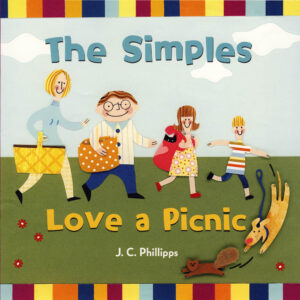 The Simples Love a Picnic
The Simples Love a Picnic
By J.C. Phillipps
Houghton Mifflin Harcourt
$16.99
ISBN: 978-0-544-16667-7
Ages 3-7
On shelves now
I am on a mission. A quest. A journey to find the funniest picture books published for children in a given year. It isn’t an easy thing to do. First, you have to deal with the sheer awe-inspiring number of picture books published these days. Then there’s the fact that funny is as funny does. What strikes me as friggin’ hilarious may not cause so much as a flick of the lips from you. This is probably why humor awards for children’s literature are few and far between. Then add in the fact that what kids find funny and what adults find funny is vastly different. If the very existence of knock knock jokes has taught us nothing it has taught us that. But you know . . . there are exceptions. I’ve seen kids and adults rolling in the aisles with a good reading of Bark, George by Jules Feiffer. I’ve seen adults laugh in honest surprise along with their kids when surprised by the events in Fortunately by Remy Charlip. And I bet your bottom dollar that if read correctly The Simples Love a Picnic by J.C. Phillipps could be one of those books a classroom of first graders fight to the death to check out from the library. The lie is in its very name: “Simple”. As a quick perusal shows, what Phillipps is able to accomplish here is anything but simplistic. After all, writing funny books is no easy task, yet The Simples Love a Picnic blows that notion right out of the water. Highly hilarious stuff.
It started off with an innocent enough suggestion. “Let’s have a picnic,” Dad proposes. The kids, Lulu and Ben, are unfamiliar with the concept, which is probably what prompts Lulu to pack a tub of ice cream amongst the supplies (her logic that “ice cream doesn’t spill” seems sound enough at the time). Off goes the family and after the occasional mishap (the dog chasing squirrels up trees, the cat appearing in Lulu’s backpack) they find themselves in the park. But locating the perfect location for a picnic turns out to be only slightly less hazardous than surviving what happens after the food comes out. In the end, the family finds the perfect place to devour a meal, though it isn’t where you might expect it to be.
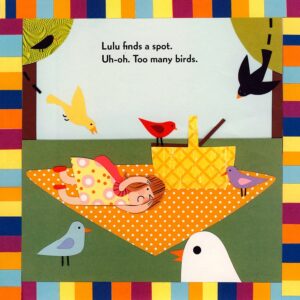 I can pinpoint the precise moment I fell in love with this book. I mean, sure I liked it from the get-go. Phillipps utilizes this cheery, upbeat can-do spirit that any child will tell you is just ASKING for trouble. And I was already pretty amused when son Ben started wondering what one eats at a picnic only to come up with a short list of what might be the worst picnic foods of all time (“Cereal?”, “Soup?”, etc.). And I could just hear myself reading this aloud to a group of kids when Rocco the dog went hell-for-leather for that squirrel up a tree (going the extra mile in turning Ben completely 180 degrees upside down). But really, it wasn’t until the picnic was underway that I went hook, line, and sinker for what Phillipps had conjured up. The family attempts to find a spot to have their picnic and Ben’s location turns out to have “Too many ants”. Pretty funny, but not as funny as Lulu’s spot. Now the sentence, “Too many birds” may not sound amusing, but suddenly Phillipps turns the scene into something out of an Alfred Hitchcock film. Lulu is seen clutching her head as, presumably, a bird dive bombs towards her, others calmly checking out the basket’s wares. This moment is echoed later when some melted ice cream sets off a kind of apocalyptic picnic frenzy of hoards of ants and even more dive-bombing birds (to say nothing of the squirrels). I’ve a weakness for any book that builds to a ridiculous climax and this one tapped into that feeling perfectly.
I can pinpoint the precise moment I fell in love with this book. I mean, sure I liked it from the get-go. Phillipps utilizes this cheery, upbeat can-do spirit that any child will tell you is just ASKING for trouble. And I was already pretty amused when son Ben started wondering what one eats at a picnic only to come up with a short list of what might be the worst picnic foods of all time (“Cereal?”, “Soup?”, etc.). And I could just hear myself reading this aloud to a group of kids when Rocco the dog went hell-for-leather for that squirrel up a tree (going the extra mile in turning Ben completely 180 degrees upside down). But really, it wasn’t until the picnic was underway that I went hook, line, and sinker for what Phillipps had conjured up. The family attempts to find a spot to have their picnic and Ben’s location turns out to have “Too many ants”. Pretty funny, but not as funny as Lulu’s spot. Now the sentence, “Too many birds” may not sound amusing, but suddenly Phillipps turns the scene into something out of an Alfred Hitchcock film. Lulu is seen clutching her head as, presumably, a bird dive bombs towards her, others calmly checking out the basket’s wares. This moment is echoed later when some melted ice cream sets off a kind of apocalyptic picnic frenzy of hoards of ants and even more dive-bombing birds (to say nothing of the squirrels). I’ve a weakness for any book that builds to a ridiculous climax and this one tapped into that feeling perfectly.
Phillipps isn’t exactly unknown to the world of funny picture books. It takes a very particular sort of brain to come up with titles like “Wink: The Ninja Who Wanted to be Noticed” (a book that was way into ninjas before the vast hoards of them published this year, by the way). From that book you got the very clear sense that Phillipps wasn’t just an author/illustrator to watch. She also was funny as all get out. Since that book’s release Ms. Phillipps has kept herself busy, but her books have always been big and bold. Ninjas and simians with names like Monkey Ono and the like. So part of what I admire so much about The Simples is that the book isn’t high-concept. On paper it doesn’t look like much: Family goes outside to picnic. Epic picnic fail. Family goes inside to picnic. Fin. Not much going on there. But what makes the book so great is that Phillipps is channeling great works of literature about seriously stupid people like The Stupids by Harry Allard and the Dumb Bunny books of Sue Denim. And in doing so, she manages to make something seriously smart.
I confess that I wonder if in this age of high self-esteem and fear of offense whether or not Allard’s books about the Stupids would be able to see the light of publication. Yet even as I say this I don’t mind the “simple” appellation Phillipps came up with here in the least. Yes, of course I’m aware of the term’s use historically as a sort of universal catchall for anyone mentally impaired. But taken in its modern context alongside the family featured here and it would take some pretty thin skin to find anything to object to. After all, this family isn’t really out-and-out dumb (though I have my worries about Ben). They just seem prone to awful decisions and bad luck. You could just as easily have named them The Schlimazels and probably would have been more accurate in the process (note to self: write picture book about The Family Schlimazel).
If the family’s actual name refers to anything then it’s probably the art style Phillipps chooses to utilize here. It utilizes the cut paper look that’s served her so well, but here she’s simplified it beyond her usual complexities. Of the family itself you’re pretty much lucky if you get so much as a line for your nose. Features are flattened, clothes cut and pasted. The result is not that a child could do this, but rather that a child could at least make an attempt at it. Yet for all that their eyes are mere dots in the head, Phillipps gets a lot of pathos and expression out of her little paper people. Whether it’s the turn of a mouth (comically upside down “u” shaped) to denote misery or the slant of an eyebrow over an eye, these people are pretty darn expressive. One should also note that Phillipps takes a page or two out of the graphic novelists’ handbooks when she splits her narratives on certain pages or makes use of distance and perspective. These people may be flat, but the storytelling never is.
This is the kind of book that tends to not get quite enough respect. It’s hardly the first picnic book in the world (love that Picnic by Emily Arnold McCully) but it may well be the most amusing. Between the psychotic birds and the suicidal squirrels there’s lots here to love. A great readaloud for groups and a hilarious romp overall, I am pleased as punch to designate this one of the funniest picture books of the year. Silly in all the right ways. Don’t miss it.
On shelves now.
Source: Galley sent from publisher for review.
Like This? Then Try:
Professional Reviews: Kirkus
Videos:
Yep! It has a trailer and everything.
And this one goes behind the scenes a bit. If nothing else, it shows us how cool it would be to live in Ms. Phillipps’ house.


By:
Betsy Bird,
on 1/6/2014
Blog:
A Fuse #8 Production
(
Login to Add to MyJacketFlap)
JacketFlap tags:
Reviews,
picture books,
Best Books,
Candlewick,
readalouds,
Steve Light,
picture book readalouds,
Best Books of 2014,
Reviews 2014,
2014 picture book readalouds,
2014 picture books,
2014 reviews,
Add a tag
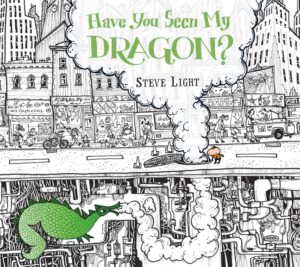 Have You Seen My Dragon?
Have You Seen My Dragon?
By Steve Light
Candlewick Press
$16.99
ISBN: 978-0-7636-6648-4
Ages 2-6
On shelves April 8th
When I grew up in Kalamazoo, Michigan I would get this little thrill every time my city appeared in a children’s book. Which is to say, every time it was mentioned in Horton Hatches the Egg. Honestly, for all that it had a cool name it really didn’t come up anywhere else. New York kids must be rather jaded in this regard. Anytime a city book is set somewhere other than Manhattan or Brooklyn, they probably scratch their little heads in confusion (I can attest to this personally as my two-year-old calls any and all cities she sees in books “New York City” and will not be corrected). As a NYC transplant I’d probably mind this more if it weren’t for the fact that so many of these books are so doggone splendid. Take Steve Light’s latest, Have You Seen My Dragon? A riot of miniscule details, numbers, colors, familiar city elements, and a magnificent, fantastic creature always hidden in plain sight, Light gives us a city dragon worth remembering long after the pages are turned.
You would think it would be difficult to mislay a dragon. You would be wrong. When our story begins a young boy is asking a doorman whether or not he’s seen his dragon. “No? I will look for him.” Never you mind that if the boy merely turned his head 90 degrees to the left he’d see his ginormous pet sniffing an understandably wary pup. From here it’s a race across the city. Everywhere the boy goes the numbers go up. The dragon perches atop a hot dog stand where they are selling “2 Hot dogs”. It peers down from a roof at the “3 Buses” below. It gets a quick drink from one of the “5 Water towers.” On the endpapers you can see the circuitous path the dragon takes through a slightly compacted lower Manhattan until, at last, the boy spots him in Chinatown, smiling widely from between the “20 Lanterns”.
 There is a perception out there that it is near impossible to publish a black and white picture book in today’s market. This may be so, but Light comes pretty darn close to doing so. Though there is a different color for every number in the book, most of what you’re seeing is just good old-fashioned pen and inks. More to the point, the man has gone rather wild in his details. I haven’t seen intricate work at this level since I read Mark Alan Stamaty’s picture book cult classic Who Needs Donuts? Whether he’s detailing the myriad wires that curl around the sewer pipes below the street or paying homage to the detailing on St. Patrick’s Cathedral, there’s a method to the man’s madness. Now add in the fact that Light isn’t afraid to go vertical with his two-page spreads and that he occasionally gets incredibly creative with his perspective (the “8 Fire hydrants” two-page spread is an exercise in internal logic) and you have a rather beautiful affair. Little wonder that he chose to only dot the pages with color. It’s lovely to watch how the artist uses these colors to direct your eye across the page.
There is a perception out there that it is near impossible to publish a black and white picture book in today’s market. This may be so, but Light comes pretty darn close to doing so. Though there is a different color for every number in the book, most of what you’re seeing is just good old-fashioned pen and inks. More to the point, the man has gone rather wild in his details. I haven’t seen intricate work at this level since I read Mark Alan Stamaty’s picture book cult classic Who Needs Donuts? Whether he’s detailing the myriad wires that curl around the sewer pipes below the street or paying homage to the detailing on St. Patrick’s Cathedral, there’s a method to the man’s madness. Now add in the fact that Light isn’t afraid to go vertical with his two-page spreads and that he occasionally gets incredibly creative with his perspective (the “8 Fire hydrants” two-page spread is an exercise in internal logic) and you have a rather beautiful affair. Little wonder that he chose to only dot the pages with color. It’s lovely to watch how the artist uses these colors to direct your eye across the page.
If the name “Steve Light” has been triggering some kind of latent amnesia in your cranium, it probably has to do with his board books with Chronicle Books. Let me tell you right now that if you have not read Trucks Go, Trains Go or Diggers Go aloud to a small child then your life, nice as it is, is little more than a pale hollow shell of what it might someday be. In those three books Light used bright, thick paints to convey an array of vehicles. He then gave each and every one of them original, amazing sounds, ideal of reading aloud either one-on-one or to a large group. Have You Seen My Dragon differs widely from that series in terms of look and feel. But what it does have in common is the age of the audience (toddler heaven is what we have going on here) and the read aloud potential. Good readalouds are rarities. For every 100 picture books published in a given season, maybe four of them are titles you’d like to test on a group of squirmy squirmers. And this, ladies and gentlemen, should be one of those four. It’s simple and interactive and I can already hear a room of small fry screaming at you as to where the dragon is “hiding”.
There may be the occasional New York child that complains that the buses in the book are purple when, in fact, our buses are no such of a thing. Meh. I say purple buses would be a heckuva lot more fun, so if Mr. Light wants to bestow that particular hue to them, let him. And that goes for the blue subway cars as well. Slightly more problematic are the “monkeys”. You will find that for the number 6 one is supposed to find “6 Monkeys”. The zoo picture is, if you follow the map, sort of supposed to be the Central Park Zoo, but it doesn’t really resemble it. That’s okay too. Artistic liberties I am a-okay with. Far more of a problem is the fact that the monkeys in question have no tails. Yup, what we’re dealing with here is a page of six apes. It’s a classic Curious George problem and not one that sinks the book or anything. Still, wouldn’t mind a tail or two on those primates. It would be just the thing.
All told, I see a lot of New York City picture books in a given year. This one goes beyond our city’s borders. It’s the kind of book that’s going to appeal to any kid that’s drawn to the hustle and bustle of a metropolitan area. The words “New York City” never even appear in the text, allowing a lot of young readers to simply think of the location as an everycity. Lithe and lovely, overflowing with good will and copious details, expect the sentence, “Have you seen Have You Seen My Dragon?” to appear on the lips of parents and children everywhere. Because if you haven’t seen it, now’s the time.
On shelves April 8th.
Source: Galley sent from publisher for review.
Like This? Then Try:


By:
Betsy Bird,
on 12/30/2012
Blog:
A Fuse #8 Production
(
Login to Add to MyJacketFlap)
JacketFlap tags:
Reviews,
Chronicle,
Best Books,
picture book reviews,
Jeremy Tankard,
David LaRochelle,
2012 picture books,
2012 reviews,
Best Books of 2012,
2012 picture book readalouds,
picture book readalouds,
Reviews 2012,
Add a tag
 It’s a Tiger!
It’s a Tiger!
By David LaRochelle
Illustrated by Jeremy Tankard
Chronicle Books
$16.99
ISBN: 978-0-8118-6925-6
Ages 4-8
On shelves now
There is an art to reading a picture book but I’ve not encountered many schools that actually teach that skill. Librarians will learn it in their graduate courses, of course, but what about parents and booksellers? Are they doomed to stumble through their readings without getting some of the insider tips and tricks? Yup, pretty much. The only thing you can really do is just recommend to them picture books that make reading aloud one-on-one or to large groups a painless experience. Books that have an inherent interior rhythm and logic that kids will naturally adhere to. So each and every year I sit and wait for those great picture book readalouds of the year. For 2012 I’ve seen a couple that lend themselves to groups. Up, Tall and High by Ethan Long is ideal for preschoolers. Creepy Carrots! by Aaron Reynolds is perfect for the 1st and 2nd graders. But the all-around best readaloud of the year, bar none as far as I can tell, has got to be It’s a Tiger! A boon to librarians and booksellers looking for new storytime fare as well as parents and grandparents, David LaRochelle’s latest is a hoot, a holler, and could even be called a hootenanny if you’re so inclined to call it that.
So you’re walking through the forest, minding your own business, checking out monkeys when you realize that the orange and black tail over there isn’t a vine at all. It’s a TIGER!! Like a shot you (which is to say, the boy in the book) take off lickety split. Still, it doesn’t matter where you go. Whatever you do, that darned tiger seems to follow. Dark caves, ships at sea, desert islands, the tiger is everywhere! At the end you realize that the tiger doesn’t really want to eat you. So to put it to sleep you decide to tell it a story. A story about a boy walking through the forest until he sees a green scaly vine. Wait a minute . . . that’s not a vine . . . .
 It took a couple readings before I realized something essential about this particular book. Turns out, this is one of the rare picture books written in the second person. You do this. You do that. The reader actually is the little boy who finds himself inexplicably running into the same orange and black foe over and over again. It’s a narrative technique that I just know that I’ve seen in picture books before, but when I try to think of them I find myself stumped. They’re not as common as you might think and I certainly can’t come up with any that are also great read alouds for large groups. By making the audience the narrator they get all the requisite chills and thrills without actually feeling like they’re in direct danger. It would be a good companion to Michael Rosen’s We’re Going On A Bear Hunt honestly. Same threat level. Same you-are-there aspects.
It took a couple readings before I realized something essential about this particular book. Turns out, this is one of the rare picture books written in the second person. You do this. You do that. The reader actually is the little boy who finds himself inexplicably running into the same orange and black foe over and over again. It’s a narrative technique that I just know that I’ve seen in picture books before, but when I try to think of them I find myself stumped. They’re not as common as you might think and I certainly can’t come up with any that are also great read alouds for large groups. By making the audience the narrator they get all the requisite chills and thrills without actually feeling like they’re in direct danger. It would be a good companion to Michael Rosen’s We’re Going On A Bear Hunt honestly. Same threat level. Same you-are-there aspects.
I think what I like best about the book is the fact that it goes from surprising to funny in fairly short order. The first three or four times you turn the page and encounter a tiger the kids are still uncertain about the order of occurrences. Once the pattern is firmly established, that’s when they can kind of let go and enjoy. Then LaRochelle ratchets up the silly factor and the kids really begin to have fun. We don’t always remember that children have a relatively refined sense of the absurd. They’re literalists, every last one, and though they might point out the flaws in your logic as you read the book (how can you swing and land on the tiger when you just escaped the tiger?) there’s a different kind of fun to be had in telling grown-ups they can’t possibly be right about something. It’s a Tiger! combines several different kinds of reading pleasures then. Interactive (kids can yell “It’s a tiger!” along with the reader). Power plays (telling adults they must be mistaken). The element of surprise. The controlled fear factor. It’s all there. And it’s awesome.
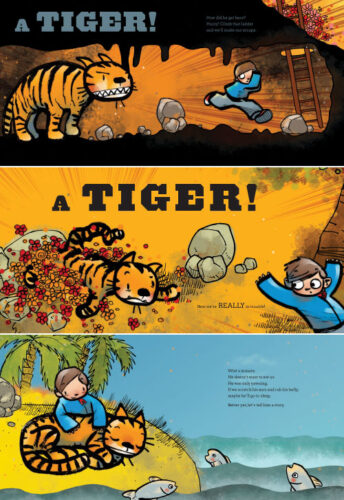 It is difficult for me to be impartial about a book that features the art of Jeremy Tankard. A couple years ago he burst onto the picture book scene with three books that changed the way I do preschool storytimes (Grumpy Bird, Me Hungry!, and Boo Hoo Bird). Even when he’s working on other people’s books, as in the case here, he has a distinctive style that can’t be beat. In this book he utilizes his usual ink and digital media style, but the colors are extraordinary. They just pop off the page with these magnificent blues, greens, oranges, yellows, and reds. It was interesting to note that the pages themselves have a sheen and gleam I’ve not noticed in a picture book before. Hold them up to the light and watch as the thick black lines and colors seem as though they should be transparent, if that makes any sense. That visual pop means that when you reach the every-other-page “surprise” of the tiger, Tankard can really make the animal’s appearance seem surprising. He uses some anime-type lines around the tiger from time to time to direct the eye to the center of the page, which as of this review still has a new and contemporary feel to it. We’ve seen it in books by folks like Dan Santat for years, of course. My suspicion is that though it will certainly make the book feel like an early-21st creation, that doesn’t mean it’ll age poorly. It’s simply a work of its time now.
It is difficult for me to be impartial about a book that features the art of Jeremy Tankard. A couple years ago he burst onto the picture book scene with three books that changed the way I do preschool storytimes (Grumpy Bird, Me Hungry!, and Boo Hoo Bird). Even when he’s working on other people’s books, as in the case here, he has a distinctive style that can’t be beat. In this book he utilizes his usual ink and digital media style, but the colors are extraordinary. They just pop off the page with these magnificent blues, greens, oranges, yellows, and reds. It was interesting to note that the pages themselves have a sheen and gleam I’ve not noticed in a picture book before. Hold them up to the light and watch as the thick black lines and colors seem as though they should be transparent, if that makes any sense. That visual pop means that when you reach the every-other-page “surprise” of the tiger, Tankard can really make the animal’s appearance seem surprising. He uses some anime-type lines around the tiger from time to time to direct the eye to the center of the page, which as of this review still has a new and contemporary feel to it. We’ve seen it in books by folks like Dan Santat for years, of course. My suspicion is that though it will certainly make the book feel like an early-21st creation, that doesn’t mean it’ll age poorly. It’s simply a work of its time now.
Long story short, we haven’t seen a boy/tiger relationship this complex since the days of Calvin and Hobbes. Tigers are such cute and cuddly carnivores, and honestly it’s very difficult to be perfectly afraid of something as soft and fluffy as a tiger. That sort of makes them ideal picture book threats. LaRochelle has written innovative picture books for years now (The End, etc.). Pairing him with Tankard just guarantees a hit. Put this one on your Must Have list and stat.
On shelves now.
Source: Final copy sent from publisher for review.
Like This? Then Try:
Other Blog Reviews:
Professional Reviews:
Other Reviews:
Interviews:
Misc:
- A behind the scenes glimpse at the making of the book.
Videos:
A handy dandy book trailer, here for the viewing.







By:
Betsy Bird,
on 9/20/2012
Blog:
A Fuse #8 Production
(
Login to Add to MyJacketFlap)
JacketFlap tags:
Peter Brown,
readalouds,
Aaron Reynolds,
2012 picture books,
2012 reviews,
Best Books of 2012,
2013 Caldecott contender,
2012 picture book readalouds,
picture book readalouds,
scary picture books,
Uncategorized,
picture books,
Add a tag
 Creepy Carrots!
Creepy Carrots!
By Aaron Reynolds
Illustrated by Peter Brown
Simon & Schuster Books for Young Readers
$16.99
ISBN: 978-1-4424-0297-3
Ages 4-8
On shelves now
A children’s librarian is half media specialist, half psychic. It isn’t enough to have to know the books in your collection. You have to know what that pint-sized patron standing before you REALLY wants when they say they want “a scary book”. For a while there I had this very persistent three-year-old who would beg me for scary fare and wait as I dutifully pulled picture book after picture book for him. After a while I’d begin to wonder what would happen if I actually gave him what he said he wanted. What if I’d handed him Alan Schwartz’s Scary Stories to Tell in the Dark)? Would it have scarred him for life? Fortunately the shelves of your average children’s room abound with titles that are “scary” enough for a small fry. The trick is to find something that manages to balance the funny and the frightening in equal measures, never overplaying its hand. Had Creepy Carrots! by Aaron Reynolds been available when I met that kid, it would have been the first thing I’d have pulled from the shelf. With pitch perfect illustration by the increasingly talented Peter Brown, this beautifully shaded creation is a great example of how to get the tone of a picture book exactly right. Strange and wonderful and weird in all the right places.
Jasper Rabbit. You average everyday hare. Jasper has a penchant for carrots. Stands to reason. He’s a rabbit. Every day he plucks them from the Crackenhopper Field. Never has a care in the world either. But one day Jasper has a suspicion. Carrots in his tummy he understands, but carrots in his bathtub? In his bedroom? In the tool shed? Seems that Jasper is being stalked by vegetation. Without realizing it, Jasper Rabbit is crossed out of his everyday existence and into . . . the carrot zone.
 Before we get into anything else, let’s talk text. As difficult as it may be, I tried reading this book without paying attention to the accompanying illustrations (no small feat) to get a sense of what author Aaron Reynolds is doing here. What I discovered when I went through it on a word alone basis was that Reynolds has penned a really good readaloud. There’s a great inherent drama to lines like, “Jasper was about to help himself to a victory snack.. when he heard it. The soft… sinister.. tunktunktunk of carrots creeping. He turned… but there was nothing there.” This passage is just begging to be read aloud with Vincent Price-esque cadences. The inherent ridiculousness of creeping carrots being scary is paired with the rather effective “tunktunktunk” sound. It reminded me of the sound of the dead son in that old short story The Monkey’s Paw. It speaks of unnatural slowness, always creepy to kids who move at lightning speeds themselves. Reading this book you hit that dichotomy of potentially frightening and potentially funny over and over until, at last, you reach the end. The book’s finale is one of those twist endings that some kids will get while others just enjoy the visuals. I love a picture book with a good twist, and so do child audiences. Particularly when they don’t see where the story is going.
Before we get into anything else, let’s talk text. As difficult as it may be, I tried reading this book without paying attention to the accompanying illustrations (no small feat) to get a sense of what author Aaron Reynolds is doing here. What I discovered when I went through it on a word alone basis was that Reynolds has penned a really good readaloud. There’s a great inherent drama to lines like, “Jasper was about to help himself to a victory snack.. when he heard it. The soft… sinister.. tunktunktunk of carrots creeping. He turned… but there was nothing there.” This passage is just begging to be read aloud with Vincent Price-esque cadences. The inherent ridiculousness of creeping carrots being scary is paired with the rather effective “tunktunktunk” sound. It reminded me of the sound of the dead son in that old short story The Monkey’s Paw. It speaks of unnatural slowness, always creepy to kids who move at lightning speeds themselves. Reading this book you hit that dichotomy of potentially frightening and potentially funny over and over until, at last, you reach the end. The book’s finale is one of those twist endings that some kids will get while others just enjoy the visuals. I love a picture book with a good twist, and so do child audiences. Particularly when they don’t see where the story is going.
It’s interesting that though Reynolds has specialized in child lit noir for years (his Joey Fly Private Eye comic books practically typify the genre) there’s nothing ostensibly noir-ish about the text for Creepy Carrots! Just the same, Peter Brown saw something atmospheric there to be plundered. The decision was the right one and Brown cleverly culled from not a single noir source but from many. There are hints of Hitchcock, Wells, Twilight Zone, and other influences (Vertigo being the most direct reference of them all). The result is a picture of psychosis running rampant. Kids are naturally afraid that there might be monsters under their beds, so they understand paranoia. Only a few books think to take advantage of that fact. Meet one of the few.
 Atmospheric black and white, when done right, yields picture book gold. Think about the Caldecott Honor winner The Spider and the Fly as illustrated in a 1920s movie house style by Tony DiTerlizzi. Brown’s work isn’t wholly black and white, of course. He allows himself a single color: orange. This is a deep dark orange though. One that goes rather well with the man’s copious shading. Previous Brown books like The Curious Garden had fun with the borders, filling them with creeping smog around the edges. In Creepy Carrots! the borders now teem with encroaching darkness. Each picture is enclosed in a black border that seeps a foglike substance into the images. It’s like watching a television show or a movie where you know something’s gonna get the hero sometime. You just don’t know when.
Atmospheric black and white, when done right, yields picture book gold. Think about the Caldecott Honor winner The Spider and the Fly as illustrated in a 1920s movie house style by Tony DiTerlizzi. Brown’s work isn’t wholly black and white, of course. He allows himself a single color: orange. This is a deep dark orange though. One that goes rather well with the man’s copious shading. Previous Brown books like The Curious Garden had fun with the borders, filling them with creeping smog around the edges. In Creepy Carrots! the borders now teem with encroaching darkness. Each picture is enclosed in a black border that seeps a foglike substance into the images. It’s like watching a television show or a movie where you know something’s gonna get the hero sometime. You just don’t know when.
Fair play to Brown with his carrots too. As you can see from the cover alone, he takes care to make them funny and scary all at once. They have a random smattering of gappy teeth like jack-o-lanterns, crossed eyes, and a variety of tops. They’re like The Three Stooges in vegetable form, only more intimidating. Brown also makes the rather interesting decision to give much of this book a cutout feel. His style consists of drawing in pencil on paper and then digitally composing and coloring his images. The result is that he can give his scenes some real depth. That first shot of Jasper sitting merrily amongst the carrots really makes it look as if he’s cut out from the scene, nearer the audience, much like the tufts of the trees behind him. And finally there’s Jasper himself. You’d think the book would just feature the regular emotions like happy and frightened, but Brown does a lot more than that. The scene where Jasper laughs at himself for being so ridiculous to think that the carrots were following him is a triumph of mixed emotions. Worried eyes, smiling mouth, uncertain eyebrows, and hubris-filled ears. Beautiful stuff.
Though it has absolutely nothing to do with Halloween, thanks to its black, white, and orange palette (to say nothing of its subject matter) expect to see this book read aloud in many a Halloween storytime for years and years to come. There are worse fates. I would simply remind everybody that scary books aren’t seasonal. That kid who requested them of me asked me for them month after month, never tiring of what I put before him. Kids love to be scared within the safety of their parents’ arms. Happy endings and gorgeous art are just a nice plus at that point. More fun than it deserves to be and thrilling to the core, expect to be asked to read this one over and over again and to willingly acquiesce so that you can pick out more details on a second, third, fortieth reading. A masterpiece of the scary/funny balance.
On shelves now.
Like This? Then Try:
Other Blog Reviews: Seven Impossible Things Before Breakfast
Professional Reviews: A star from Kirkus
Videos:
Don’t believe me when I say Peter Brown was influenced by certain noirish folks? Then get it straight from the horse’s mouth:
 Jonathan & Martha
Jonathan & Martha
By Petr Horacek
Phaidon Press Inc.
$14.95
ISBN: 978-0-7148-6351-1
Ages 3-7
On shelves now
Ever tried to write a picture book before? Blooming bloody hard work they are. Synthesizing a point down to as few words as possible without sacrificing story or character is akin to trying to cram a muffin into a mouse hole. It takes skill and talent, particularly if your subject matter is broad. I’ve recently come to the conclusion that if you’re dealing with a very specific subject, like a baby train robber or a dog that wants to fly a rocket to the moon, that is far and away much easier to write about than the big concepts like “love” or “need” or “friendship”. Friendship, as it happens, is at least a little easier since you can pep up your storyline with lots of superfluous details and folderol if needs be. That’s why I sort of get floored when I see something as simple and perfect as Jonathan & Martha. With art and design so beautiful you just want to stroke the pages for a couple hours, as well as story and characters that stand out and demand to be noticed, the eminent Czech author/illustrator Petr Horacek outdoes himself and makes the rest of us a little jealous that he can make it look so very easy.
When we meet our heroes, Jonathan and Martha are two lonely worms living on either side of a large pear tree. One day a magnificently sized green pear falls to the ground. Unaware of the others’ presence, the two eat their way into a fast acquaintance. They immediately set about fighting one another, only to find that their tails are now inextricably linked. Forced to share, the two discover the pleasure of enjoying food, large and small, together. And when a hungry birdie finds a fast (and mildly painful) way of separating them, they now like sharing so much that they’re willing to keep on doing it. Tangled tails or no.
 How often do you pet the pages of your picture books? I’m not talking about those tactile board books with their fur and scale elements. No, I mean beautifully crafted picture books where the very paper feels like it could stand up to wind, rain and storm. Books where part of the joy is in running your fingertips over the raised thick illustrations on the book jacket (a pleasure sadly lost to any library system that protects those jackets with plastic covers). Phaidon has pulled out all the stops with this little British import, lavishing their title with thick papers, beautiful die-cuts, covers that beg to be touched, and enough colors to pop out an eye or two.
How often do you pet the pages of your picture books? I’m not talking about those tactile board books with their fur and scale elements. No, I mean beautifully crafted picture books where the very paper feels like it could stand up to wind, rain and storm. Books where part of the joy is in running your fingertips over the raised thick illustrations on the book jacket (a pleasure sadly lost to any library system that protects those jackets with plastic covers). Phaidon has pulled out all the stops with this little British import, lavishing their title with thick papers, beautiful die-cuts, covers that beg to be touched, and enough colors to pop out an eye or two.
All that designy stuff aside (and, let’s admit it, that’s just the stuff that gets adults shopping in museum gift shops excited rather than children) there’s a ton of kid appeal to be found here. I have two words for you: worm headlock. Now tell me you’re not interested in seeing that. The book itself looks like it was created in the Eric Carle vein, with beautiful painted sections found alongside parts that may or may not be computer generated (on Horacek’s artistic style the book remains mum). Getting right down to the characters of Jonathan and Martha themselves, I found myself hugely pleased that Horacek chose to make them almost physically identical. Many’s the artist who would have felt obligated to make clear Martha’s femininity with some kind of bow or some long overwrought eyelashes. Part of the charm of the story, though, is the fact that the two worms are pretty much identical (Jonathan’s a touch longer in the tail). Feminizing details would be at odds here.
 And did I happen to mention that it reads aloud well? It’s a big book, you see, weighing at around 9″ x 9″. That means it really pops when you read it in a storytime. When you hold it high, a room full of children can make out the details perfectly. And as anyone with any readaloud experience will tell you, die-cuts are a reader’s best friend. It doesn’t hurt matters any that the words work just splendidly as well. I remember a couple of years ago when Horacek’s Silly Suzy Goose was brought to the States and readers were split into two factions. On the one hand you had the folks who thought it was a gift of a readaloud destined for storytime greatness. On the other hand there were a lot of people (present company included) driven positively mad by some of the phrases in the book. No such problems exist here. The writing is incredibly simple and straightforward, punctuated occasionally by a little “Ouch!” on occasion. There’s not a child alive who could watch that ginormous hungry bird and not feel some twinge of fear for the fate of our tangled twosome.
And did I happen to mention that it reads aloud well? It’s a big book, you see, weighing at around 9″ x 9″. That means it really pops when you read it in a storytime. When you hold it high, a room full of children can make out the details perfectly. And as anyone with any readaloud experience will tell you, die-cuts are a reader’s best friend. It doesn’t hurt matters any that the words work just splendidly as well. I remember a couple of years ago when Horacek’s Silly Suzy Goose was brought to the States and readers were split into two factions. On the one hand you had the folks who thought it was a gift of a readaloud destined for storytime greatness. On the other hand there were a lot of people (present company included) driven positively mad by some of the phrases in the book. No such problems exist here. The writing is incredibly simple and straightforward, punctuated occasionally by a little “Ouch!” on occasion. There’s not a child alive who could watch that ginormous hungry bird and not feel some twinge of fear for the fate of our tangled twosome.
Lots of other picture books come to mind when I read this book. The die-cuts evoke The Very Hungry Caterpillar while the idea of two enemies stuck together so that they become friends is akin to Randy Cecil’s beautifully twisted Horsefly and Honeybee. Jonathan & Martha is clearly it’s own queer little beastie, though. Eye-catching enough to arouse the interest of even the snottiest adult consumer but kid-friendly enough to pass the fearful readaloud-to-a-large-group test, this is the rare book that pleases highbrow and lowbrow alike. Fun and fanciful and far and away one of the best little picture books of the year. You’d do well to make its acquaintance.
On shelves now.
Source: Final copy sent from publisher for review.
Like This? Then Try:
Misc:
- I just wasted a good chunk of my evening having fun reading Mr. Horacek’s blog. Have yourself a bit of fun and waste your day doing the same.
And check out this cool cover of the same book from what I believe to be the UK!

 To be fair, every single picture book, with the exception of the wordless ones, is a readaloud. You’re not supposed to just silent there silent and stony when a child’s on your lap. Picture books are meant to engage through the voice of the reader. That said, not all of them do well when it comes to reading them to groups. When I first because a children’s librarian I learned the hard way that some classic titles (Horton Hatches the Egg, Blueberries for Sal, etc.) die ignoble deaths at your hands when read to groups of preschoolers. I began to rely on a core group of picture books with every storytime. The danger with that, though, is that you never try anything new.
To be fair, every single picture book, with the exception of the wordless ones, is a readaloud. You’re not supposed to just silent there silent and stony when a child’s on your lap. Picture books are meant to engage through the voice of the reader. That said, not all of them do well when it comes to reading them to groups. When I first because a children’s librarian I learned the hard way that some classic titles (Horton Hatches the Egg, Blueberries for Sal, etc.) die ignoble deaths at your hands when read to groups of preschoolers. I began to rely on a core group of picture books with every storytime. The danger with that, though, is that you never try anything new. Try running around the room with this one, getting the kids to touch the witch’s warts, pet the monsters’ fur, and stick their hands in the slathering jaws of hungry beasts. As long as it keeps in one piece, it will be beloved.
Try running around the room with this one, getting the kids to touch the witch’s warts, pet the monsters’ fur, and stick their hands in the slathering jaws of hungry beasts. As long as it keeps in one piece, it will be beloved.


























































I always enjoy hearing the grownups laugh when I read a Jan Thomas book in story time.
One of life’s great pleasures.